






































































































|
Pathiramanal (Bird Sanctuary)

This 10 acre island on the backwaters is home to many rare varieties
of migratory birds from different parts of the world. According to
mythology a young brahmin dived into the Vembanad Lake to perform
his evening ablutions and the water made way for land to rise from
below, thus creating the enchanting island, Pathiramanal (sands of
midnight).
The Best Time to Visit Pathiramanal
is from June to January.
Birdwatching
The island is a Birdwatcher's paradise. It is home to around 91
local species of birds and 50 migratory birds. One can see Pintail
Ducks, Common Teal, Night Heron, Cormorant, Darter, Indian Shag,
Purple Heron, gulls, terns, large egrets, Intermediate Egret, Cattle
Egret, Indian Pond Heron, Little Egret, Pheasant-tailed and Bronze-winged
Jacanas, Stork-billed Kingfisher, Watercock, Whistling Duck, Cotton
Pygmy-Goose, Little Cormorant and Whiskered Tern. Some people have
even reported seeing the Monarch flycatcher.
:::::::::::::::::::::::::::::::::::::::::::::::::::::::::::::::::::::::::::::::::::::::::::::::::::::::::::::::::::::::::::::::::::::::::::::::::::::::::::::::::::::::::::::::::::::::::::::::::::::::::::::::::::::::::::::::::::
Cattle
Egret |
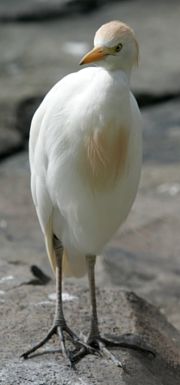
Breeding adult of nominate subspecies |
| Conservation
status |
| Least
Concern (IUCN 3.1)[1] |
Scientific
classification |
| Kingdom |
Animalia |
| Phylum: |
Chordata |
| Class: |
Aves |
| Order: |
Ciconiiformes |
| Family: |
Ardeidae |
| Genus: |
Bubulcus
Bonaparte, 1855 |
| Species: |
B.
ibis |
| Binomial
name |
Bubulcus
ibis
Linnaeus, 1758 |
Subspecies |
B.
i. ibis
Linnaeus, 1758
B. i. seychellarum
Salomonsen, 1934
B. i. coromandus
Boddaert, 1783 |
Synonyms |
Ardea
ibis
Buphus coromandus
Cancroma coromanda
Lepterodatis ibis
Bubulcus bubulcus |
The Cattle Egret (Bubulcus ibis) is a
cosmopolitan species of heron (family Ardeidae) found in the tropics,
subtropics and warm temperate zones. It is the only member of the
monotypic genus Bubulcus, although some
authorities regard its two subspecies as full species. Despite the
similarities in plumage to the egrets of the genus Egretta, it is
more closely related to the herons of Ardea. Originally native to
parts of Asia, Africa and Europe, it has undergone a rapid expansion
in its distribution and successfully colonised much of the rest
of the world.
It is a stocky white bird adorned with buff plumes in the breeding
season which nests in colonies, usually near bodies of water and
often with other wading birds. The nest is a platform of sticks
in trees or shrubs. Unlike most other herons, it feeds in relatively
dry grassy habitats, often accompanying cattle or other large mammals,
since it catches insect and small vertebrate prey disturbed by these
animals. Some populations of the Cattle Egret are migratory and
others show post-breeding dispersal.
The adult Cattle Egret has few predators, but birds or mammals may
raid its nests, and chicks may be lost to starvation, calcium deficiency
or disturbance from other large birds. This species removes ticks
and flies from cattle, but it can be a safety hazard at airfields,
and has been implicated in the spread of tick-borne animal diseases.
Taxonomy
The Cattle Egret was first described in 1758 by Linnaeus in his
Systema naturae as Ardea ibis,but was moved to its current genus
by Charles Lucien Bonaparte in 1855. Its genus name Bubulcus is
Latin for herdsman, referring, like the English name, to this species'
association with cattle[Ibis is a Latin and Greek word which originally
referred to another white wading bird, the Sacred Ibis.
The Cattle Egret has two geographical races which are sometimes
classified as full species, the Western Cattle Egret, B. ibis, and
Eastern Cattle Egret, B. coromandus. The two forms were split by
McAllan and Bruce but were regarded as conspecific by almost all
other recent authors until the publication of the influential Birds
of South Asia.The eastern subspecies B. (i.) coromandus, described
by Pieter Boddaert in 1783, breeds in Asia and Australasia, and
the western nominate form occupies the rest of the species's range,
including the Americas.Some authorities recognise a third Seychelles
subspecies, B. i. seychellarum, which was first described by Finn
Salomonsen in 1934.
Despite superficial similarities in appearance, the Cattle Egret
is more closely related to the genus Ardea, which comprises the
great or typical herons and the Great Egret (A. alba), than to the
majority of species termed egrets in the genus Egretta. Rare cases
of hybridization with Egretta caerulea, Egretta garzetta and Egretta
thula have been recorded.
Description
The Cattle Egret is a stocky heron with a 88–96 cm (35–38
in) wingspan; it is 46–56 centimetres (18–22 in) in
length and weighs 270–512 grams (9.5–18.1 oz). It has
a relatively short thick neck, sturdy bill, and a hunched posture.
The non-breeding adult has mainly white plumage, a yellow bill and
greyish-yellow legs. During the breeding season, adults of the nominate
western subspecies develop orange-buff plumes on the back, breast
and crown, and the bill, legs and irises become bright red for a
brief period prior to pairing. The sexes are similar, but the male
is marginally larger and has slightly longer breeding plumes than
the female; juvenile birds lack coloured plumes and have a black
bill.
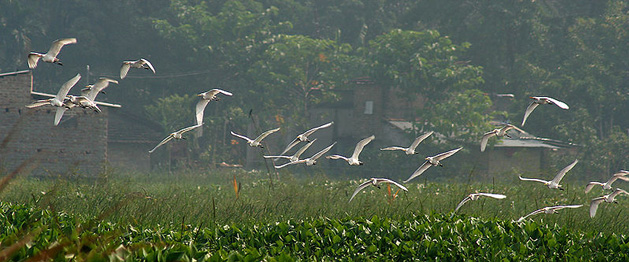
Breeding plumage adult B. i. coromandus
B. i. coromandus differs from the nominate subspecies in breeding
plumage, when the buff colour on its head extends to the cheeks
and throat, and the plumes are more golden in colour. This subspecies'
bill and tarsus are longer on average than in B. i. ibis. B. i.
seychellarum is smaller and shorter-winged than the other forms.
It has white cheeks and throat, like B. i. ibis, but the nuptial
plumes are golden, as with B. i. coromandus.
The positioning of the egret's eyes allows for binocular vision
during feeding, and physiological studies suggest that the species
may be capable of crepuscular or nocturnal activity. Adapted to
foraging on land, they have lost the ability possessed by their
wetland relatives to accurately correct for light refraction by
water.
This species gives a quiet, throaty "rick-rack" call at
the breeding colony, but is otherwise largely silent.
Distribution and habitat
Typical grassland habitat
The Cattle Egret has undergone one of the most rapid and wide reaching
natural expansions of any bird species. It was originally native
to parts of Southern Spain and Portugal, tropical and subtropical
Africa and humid tropical and subtropical Asia. In the end of the
19th century it began expanding its range into southern Africa,
first breeding in the Cape Province in 1908 Cattle Egrets were first
sighted in the Americas on the boundary of Guiana and Suriname in
1877, having apparently flown across the Atlantic Ocean. It was
not until the 1930s that the species is thought to have become established
in that area.
The species first arrived in North America in 1941 (these early
sightings were originally dismissed as escapees), bred in Florida
in 1953, and spread rapidly, breeding for the first time in Canada
in 1962 It is now commonly seen as far west as California. It was
first recorded breeding in Cuba in 1957, in Costa Rica in 1958,
and in Mexico in 1963, although it was probably established before
that. In Europe the species had historically declined in Spain and
Portugal, but in the latter part of the 20th century it expanded
back through the Iberian Peninsula, and then began to colonise other
parts of Europe; southern France in 1958, northern France in 1981
and Italy in 1985 Breeding in the United Kingdom was recorded for
the first time in 2008.
In Australia the colonisation began in the 1940s, with the species
establishing itself in the north and East of the continent. It began
to regularly visit New Zealand in the 1960s.
Looking for prey disturbed by a water buffalo
The massive and rapid expansion of the Cattle Egret's range is due
to its relationship with humans and their domesticated animals.
Originally adapted to a commensal relationship with large browsing
animals, it was easily able to switch to domesticated cattle and
horses. As livestock keeping spread throughout the world it was
able to occupy otherwise empty niches. Many populations of Cattle
Egrets are highly migratory and dispersive, and this has helped
the species' range expansion. The species has been seen as a vagrant
in various sub-Antarctic islands, including South Georgia, Marion
Island, the South Sandwich Islands and the South Orkney Islands
A small flock of eight birds was also seen in Fiji in 2008.
In addition to the natural expansion of its range, Cattle Egrets
have been introduced into a few areas. The species was introduced
to Hawaii in 1959, and to the Chagos Archipelago in 1955. Successful
releases were also made in the Seychelles and Rodrigues, but attempts
to introduce the species to Mauritius failed. Numerous birds were
also released by Whipsnade Zoo in England, but the species never
established.
Although the Cattle Egret sometimes feeds in shallow water, unlike
most herons it is typically found in fields and dry grassy habitats,
reflecting its greater dietary reliance on terrestrial insects rather
than aquatic prey.
Migration and movements
Some populations of Cattle Egrets are migratory, others
are dispersive, and distinguishing between the two can be difficult
for this species. In many areas populations can be both sedentary
and migratory. In the northern hemisphere migration is from cooler
climes to warmer areas, but Cattle Egrets nesting in Australia migrate
to cooler Tasmania and New Zealand in the winter and return in the
spring. Migration in western Africa is in response to rainfall,
and in South America migrating birds travel south of their breeding
range in the non breeding season. Populations in southern India
appear to show local migrations in response to the monsoons. They
move north from Kerala after September. During winter, many birds
have been seen flying at night with flocks of Indian Pond Herons
(Ardeola grayii) on the southeastern coast of India and a winter
influx has also been noted in Sri Lanka.
Young birds are known to disperse up to 5,000 km (3,100 mi) from
their breeding area. Flocks may fly vast distances and have been
seen over seas and oceans including in the middle of the Atlantic.
Status
This species has a large range, with an estimated global
extent of occurrence of 10 million square kilometres (3.8 square
miles). Its global population estimated to be 3.8–6.7 million
individuals. For these reasons, the species is evaluated as Least
Concern. On the other hand the expansion and establishment of the
species over large ranges has led it to be classed as an invasive
species (although little, if any impact has been noted yet).
behaviour
Breeding
This eastern race adult shows the red flush on the legs and bill
present at the height of the breeding season.
The Cattle Egret nests in colonies, which are often, but not always,
found around bodies of water.[ The colonies are usually found in
woodlands near lakes or rivers, in swamps, or on small inland or
coastal islands, and are sometimes shared with other wetland birds,
such as herons, egrets, ibises and cormorants. The breeding season
varies within South Asia. Nesting in northern India begins with
the onset of monsoons in MayThe breeding season in Australia is
November to early January, with one brood laid per season. The North
American breeding season lasts from April to October. In the Seychelles,
the breeding season of the subspecies B.i. seychellarum is April
to October.
The male displays in a tree in the colony, using an range of ritualised
behaviours such as shaking a twig and sky-pointing (raising bill
vertically upwards), and the pair forms over three or four days.
A new mate is chosen in each season and when re-nesting following
nest failure. The nest is a small untidy platform of sticks in a
tree or shrub constructed by both parents. Sticks are collected
by the male and arranged by the female, and stick-stealing is rife.
The clutch size can be anywhere from one to five eggs, although
three or four is most common. The pale bluish-white eggs are oval-shaped
and measure 45 mm x 53 mm. (1.8–2.1 in) Incubation lasts around
23 days, with both sexes sharing incubation duties.]The chicks are
partly covered with down at hatching, but are not capable of fending
for themselves; they become endothermic at 9–12 days and fully
feathered in 13–21 days. They begin to leave the nest and
climb around at 2 weeks, fledge at 30 days and become independent
at around the 45th day.
The Cattle Egret engages in low levels of brood parasitism, and
there are a few instances of Cattle Egret eggs being laid in the
nests of Snowy Egrets and Little Blue Herons, although these eggs
seldom hatch. There is also evidence of low levels of intraspecific
brood parasitism, with females laying eggs in the nests of other
Cattle Egrets. As much as 30% extra-pair copulations have been noted.
The dominant factor in nesting mortality is starvation. Sibling
rivalry can be intense, and in South Africa third and fourth chicks
inevitably starve. In the dryer habitats with fewer amphibians the
diet may lack sufficient vertebrate content and may cause bone abnormalities
in growing chicks due to calcium deficiency. In Barbados, nests
were sometimes raided by vervet monkeys, and a study in Florida
reported the Fish Crow and black rat as other possible nest raiders.
The same study attributed some nestling mortality to Brown Pelicans
nesting in the vicinity, which accidentally, but frequently, dislodged
nests or caused nestlings to fall. In Australia, Torresian Crows,
Wedge-tailed Eagles and White-bellied Sea Eagles take eggs or young,
and tick infestation and viral infections may also be causes of
mortality
Feeding
Breeding eastern race adult with a frog
The Cattle Egret feeds on a wide range of prey, particularly insects,
especially grasshoppers, crickets, flies, and moths, as well as
spiders, frogs, and earthworms.[43][44] In a rare instance they
have been observed foraging along the branches of a Banyan tree
for ripe figs. The species is usually found with cattle and other
large grazing and browsing animals, and catches small creatures
disturbed by the mammals. Studies have shown that Cattle Egret foraging
success is much higher when foraging near a large animal than when
feeding singly. When foraging with cattle, it has been shown to
be 3.6 times more successful in capturing prey than when foraging
alone. Its performance is similar when it follows farm machinery,
but it is forced to move more.
A Cattle Egret will weakly defend the area around a grazing animal
against others of the same species, but if the area is swamped by
egrets it will give up and continue foraging elsewhere. Where numerous
large animals are present, Cattle Egrets selectively forage around
species that move at around 5–15 steps per minute, avoiding
faster and slower moving herds; in Africa, Cattle Egrets selectively
foraged behind Plains Zebras, Waterbuck, Blue Wildebeest and Cape
Buffalo Dominant birds feed nearest to the host, and obtain more
food.
The Cattle Egret may also show versatility in its diet. On islands
with seabird colonies, it will prey on the eggs and chicks of terns
and other seabirds. During migration it has also been reported to
eat exhausted migrating landbirds. Birds of the Seychelles race
also indulge in some kleptoparasitism, chasing the chicks of Sooty
Terns and forcing them to disgorge food.
Non-breeding plumage
Relationship with humans
A conspicuous species, the Cattle Egret has attracted many
common names. These mostly relate to its habit of following cattle
and other large animals, and it is known variously as cow crane,
cow bird or cow heron, or even elephant bird, rhinoceros egret.
Its Arabic name, abu qerdan, means “father of ticks",
a name derived from the huge number of parasites such as avian ticks
found in its breeding colonies.
The Cattle Egret is a popular bird with cattle ranchers for its
perceived role as a biocontrol of cattle parasites such as ticks
and flies.A study in Australia found that Cattle Egrets reduced
the number of flies that bothered cattle by pecking them directly
off the skin. It was the benefit to stock that prompted ranchers
and the Hawaiian Board of Agriculture and Forestry to release the
species in Hawaii.
Not all interactions between humans and Cattle Egrets are beneficial.
The Cattle Egret can be a potential safety hazard due to its habit
of feeding in large groups in the grassy verges of airports and
it has been implicated in the spread of animal infections such as
heartwater and possibly Newcastle disease
:::::::::::::::::::::::::::::::::::::::::::::::::::::::::::::::::::::::::::::::::::::::::::::::::::::::::::::::::::::::::::::::::::::::::::::::::::::::::::::::::::::::::::::::::::::::::::::::::::::::::::::::::::::::::::::::::
Common
Teal
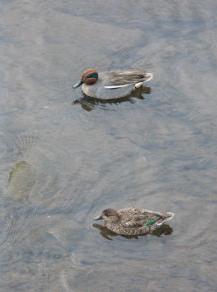
Common Teal |
Male
in nuptial plumage (above) and female.
Note typical wide white wing stripe and conspicuous face markings
of male. |
Conservation
status |
| Least
Concern (IUCN 3.1) |
Scientific
classification |
| Kingdom |
Animalia |
| Phylum: |
Chordata |
| Class: |
Aves |
| Superorder: |
Galloanserae |
| Order: |
Anseriformes |
| Family: |
Anatinae |
| Genus: |
Anas |
| Species: |
A.
crecca |
Binomial
name |
Anas
crecca
Linnaeus, 1758 |
Global
range.
Light green: summer only |
Dark
green: all year
Blue: winter only |
Synonyms |
Anas
crecca crecca Linnaeus, 1758
Anas crecca nimia Friedmann, 1948 |
The Common Teal or Eurasian Teal (Anas crecca)
is a common and widespread duck which breeds in temperate Eurasia
and migrates south in winter. It is the Old World counterpart of the
North American Green-winged Teal ( A. carolinensis), which was formerly
(and sometimes is still) considered a subspecies of A. crecca. The
Common Teal often simply called "the teal"
due to being the only one of these small dabbling ducks in much of
its range.
Description
The Common Teal is the smallest dabbling duck alive, at 34-43
cm (13-17 in) length and with an average weight of 360 g (13 oz) in
drake (males) and 340 g (12 oz) in hens (females). The wings are 17.5-20.4
cm (6.9-8.0 in) long, yielding a wingspan of 53-59 cm (21-23 in).
The bill measures 3.2-4 cm (1.3-1.6 in) in length, and the tarsus
2.8-3.4 cm (1.1-1.3 in).
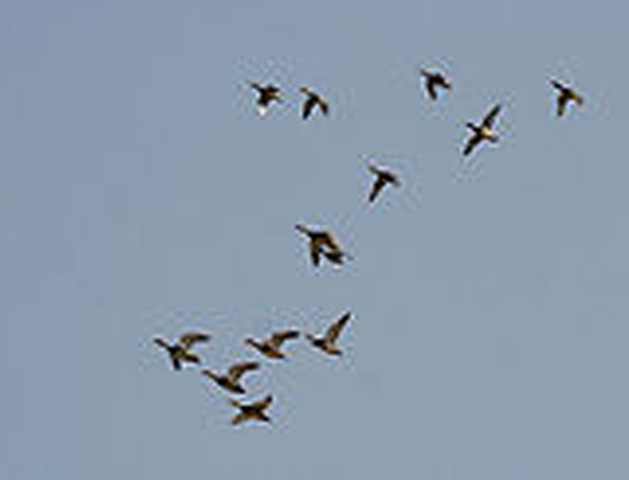
Drake in nuptial plumage
From a distance, the drakes in nuptial plumage appear grey, with a
dark head, a yellowish behind, and a white stripe running along the
flanks. Their head and upper neck ist chestnut, with a wide and iridescent
dark green patch of half-moon- or teardrop-shape that starts immediately
before the eye and arcs to the upper hindneck. The patch is bordered
with thin yellowsh-white lines, and a single line of that colour extends
from the patch's forward end, curving along the base of the bill.
The breast is buff with small round brown spots. The center of the
belly is white, and the rest of the body plumage is mostly white with
thin and dense blackish vermiculations, appearing medium grey even
at a short distance. The outer scapular feathers are white, with a
black border to the outer vanes, and form the white side-stripe when
the bird is in resting position. The primary remiges are dark greyish
brown; the speculum feathers are iridescent blackish-green with white
tips, and form the speculum together with the yellowish-white tips
of the larger upperwing coverts (which are otherwise grey). The underwing
is whitish, with grey remiges, dense dark spotting on the inner coverts
and a dark leading edge. The tail and tail coverts are black, with
a bright yellowish-buff triangular patch in the center of the coverts
at each side.
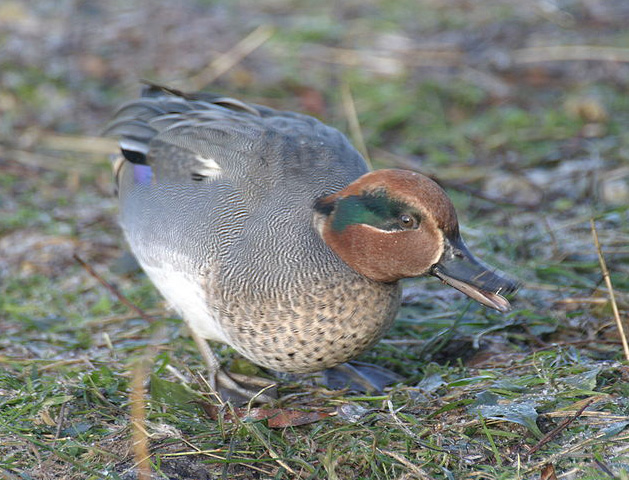
Drake in eclipse plumage (rightmost bird), hen and young
In non-breeding (eclipse) plumage, the drake looks more like the hen;
it is more uniform in colour, with a dark head and vestigial facial
markings. The hen itself is yellowish-brown, somewhat darker on wings
and back. It has a dark greyish-brown upper head, hindneck, eyestripe
and feather pattern. The pattern is dense short streaks on the head
and neck, and scaly spots on the rest of the body; overall they look
much like a tiny Mallard (A. platyrhynchos) hen when at rest. The
wings are coloured similar to the drake's, but with brown instead
of grey upperwing coverts that have less wide tips, and wider tips
of the speculum feathers. The hen's rectrices have yellowish-white
tips; the midbelly is whitish with some dark streaking.
Immatures are coloured much like hens, but have a stronger pattern.
The downy young are coloured like in other dabbling ducks: brown above
and yellow below, with a yellow supercilium. They are recognizable
by their tiny size however, weighing just 15 grams (about half an
ounce) at hatching.
Hen
The drake's bill is dark grey, in eclipse plumage often with some
light greenish or brownish hue at the base. The bill of hens and immatures
is pinkish or yellowish at the base, becoming dark grey towards the
tip; the grey expands basewards as the birds age. The feet are dark
grey in males and greyish olive or greyish-brown in females and immatures.
The iris is always brown. This is a noisy species. The male whistles
cryc or creelycc, not loud but very clear and far-carrying. The female
has a feeble keh or neeh quack.
Males in nuptial plumage are distinguished from Green-winged Teals
by the horizontal white scapular stripe, the lack of a vertical white
bar at the breast sides, and the quite conspicuous light outlines
of the face patch, which are indistinct in the Green-winged Teal drake.
Males in eclipse plumage, females and immatures are best recognized
by their small size, calls, and the speculum; they are hard to tell
apart from the Green-winged Teal however.
Range
Wintering birds at Purbasthali, Burdwan District of West
Bengal (India)
The Common Teal breeds across northern Eurasia and mostly winters
well south of its breeding range. However, in the milder climate of
temperate Europe, the summer and winter ranges overlap. For example,
in the United Kingdom a small summer population breeds, but far greater
numbers of Siberian birds arrive in winter. In the Caucasus region,
western Asia Minor, along the northern shores of the Black Sea, and
even on the south coast of Iceland and on the Vestmannaeyjar, the
species can be encountered all year, too.
In winter, there are high densities around the Mediterranean –
including the entire Iberian Peninsula and extending west to Mauretania
–, on Japan and Taiwan, as well as in South Asia. Other important
wintering locations include almost the entire length of the Nile Valley,
the Near East and Persian Gulf region, the mountain ranges of northern
Iran, and South Korea and continental East and Southeast Asia. More
isolated wintering grounds are Lake Victoria, the Senegal River estuary,
the swamps of the upper Congo River, the inland and sea deltas of
the Niger River, and the central Indus River valley. Vagrants have
been seen in inland Zaire, Malaysia, on Greenland, and on the Marianas,
Palau and Yap in Micronesia[17]; they are regularly recorded on the
North American coasts south to California and South Carolina.
Ecology and status
This dabbling duck is highly gregarious outside of the breeding season
and will form large flocks. In flight, the fast, twisting flocks resemble
waders; despite its short legs, it is also rather nimble on the ground
by ducks' standards. In the breeding season, it is a common inhabitant
of sheltered freshwater wetlands with some tall vegetation, such as
taiga bogs or small lakes and ponds with extensive reedbeds. In winter,
it is often seen in brackish waters and even in sheltered inlets and
lagoons along the seashore.
The Common Teal usually feeds by dabbling, upending or grazing; it
may submerge its head and on occasion even dive to reach food. In
the breeding season it eats mainly aquatic invertebrates, such as
crustaceans, insects and their larvae, molluscs and worms. In winter,
it shifts to a largely granivorous diet, feeding on seeds of aquatic
plants and grasses, including sedges and grains. Diurnal throughout
the breeding season, in winter they are often crepuscular or even
nocturnal feeders.
It nests on the ground, near water and under cover. The pairs form
in the winter quarters and arrive on the breeding grounds together,
starting about March. The breeding starts some weeks thereafter, not
until May in the most northernly locations. The nest is a deep hollow
lined with dry leaves and down feathers, built in dense vegetation
near water. After the females have started laying, the males leave
them and move away for shorter or longer distances, assembling in
flocks on particular lakes where they moult into eclipse plumage;
they will usually encounter their offspring only in winter quarters.
The clutch may consist of 5-16 eggs, but usually numbers 8-11; they
are incubated for 21-23 days. The young leave the nest soon after
hatching and are attended by the mother for about 25-30 days, after
which they fledge. The drakes and the hens with young generally move
to the winter quarters separately. After the first winter, the young
moult into adult plumage. The maximum recorded lifespan – though
it is not clear whether this refers to the Common or the Green-winged
Teal – was over 27 years, which is rather high for such a small
bird.
Altogether, the Common Teal is much less common than its American
counterpart, though still very plentiful. Its numbers are mainly assessed
by counts of wintering birds; some 750,000 are recorded annually around
the Mediterranean and Black Seas, 250,000 in temperate western Europe,
and more than 110,000 in Japan. In 1990 and 1991, a more detailed
census was undertaken, yielding over 210,000 birds wintering in Iran,
some 109,000 in Pakistan, about 77,000 in Azerbaidzhan, some 37,000
in India, 28,000 in Israel, over 14,000 in Turkmenistan and almost
12,000 in Taiwan. It appears to be holding its own currently, with
its slow decline of maybe 1-2% annually in the 1990s – presumably
mainly due to drainage and pollution of wetlands – not warranting
action other than continuing to monitor the population and possibly
providing better protection for habitat on the wintering grounds.
The IUCN and BirdLife International classify the Common Teal as a
Species of Least Concern, unchanged from their assessment before the
split of the more numerous A. carolinensis.
The Common Teal is one of the species to which the Agreement on the
Conservation of African-Eurasian Migratory Waterbirds (AEWA) applies.
:::::::::::::::::::::::::::::::::::::::::::::::::::::::::::::::::::::::::::::::::::::::::::::::::::::::::::::::::::::::::::::::::::::::::::::::::::::::::::::::::::::::::::::::::::::::::::::::::::::::::::::::::::::::::::::::::::
Cormorant
Cormorants
and shags
Fossil range: Late Cretaceous - Recent |

Little Pied Cormorant
Phalacrocorax melanoleucos |
Scientific
classification |
| Kingdom |
Animalia |
| Phylum: |
Chordata |
| Class: |
Aves |
| Subclass: |
Neornithes |
| Infraclass |
Neoaves |
| Order: |
Pelecaniformes |
| Suborder: |
Sulae |
| Family: |
Phalacrocoracidae
Reichenbach, 1850 |
| Genus: |
Phalacrocorax
(but see text)
Brisson, 1760 |
Species |
| 3-43,
see text |
| Synonyms |
Australocorax
Lambrecht, 1931
Compsohalieus B. Brewer & Ridgway, 1884
Cormoranus Baillon, 1834
Dilophalieus Coues, 1903
Ecmeles Gistel, 1848
Euleucocarbo Voisin, 1973
Halietor Heine, 1860
Hydrocorax Vieillot, 1819 (non Brisson, 1760: preoccupied)
Hypoleucus Reichenbach, 1852
Leucocarbo Bonaparte, 1857
Microcarbo Bonaparte, 1856
Miocorax Lambrecht, 1933
Nannopterum Sharpe, 1899
Nesocarbo Voisin, 1973
Notocarbo Siegel-Causey, 1988
Pallasicarbo Coues, 1903
Paracorax Lambrecht, 1933
Poikilocarbo Boetticher, 1935
Pliocarbo Tugarinov, 1940
Stictocarbo Bonaparte, 1855
Viguacarbo Coues, 1903
(but see text) |
The bird family Phalacrocoracidae is represented
by some 40 species of cormorants and shags.
Several different classifications of the family have been
proposed recently, and the number of genera is disputed.
Names
There is no consistent distinction between cormorants and shags. The
names "cormorant" and "shag" were originally the
common names of the two species of the family found in Great Britain,
Phalacrocorax carbo (now referred to by ornithologists
as the Great Cormorant) and P. aristotelis (the Common Shag).
"Shag" refers to the bird's crest, which the British forms
of the Great Cormorant lack. As other species were discovered by English-speaking
sailors and explorers elsewhere in the world, some were called cormorants
and some shags, depending on whether they had crests or not. Sometimes
the same species is called a cormorant in one part of the world and
a shag in another, e.g., the Great Cormorant is called the Black Shag
in New Zealand (the birds found in Australasia have a crest that is
absent in European members of the species). Van Tets (1976) proposed
to divide the family into two genera and attach the name "Cormorant"
to one and "Shag" to the other, but this flies in the face
of common usage and has not been widely adopted.
The scientific genus name is latinized Ancient Greek, from fa?a????
(phalakros, "bald") and ???a? (korax, "raven").
This is often thought to refer to the creamy white patch on the cheeks
of adult Great Cormorants, or the ornamental white head plumes prominent
in Mediterranean birds of this species, but is certainly not a unifying
characteristic of cormorants. "Cormorant" is a contraction
derived from Latin corvus marinus, "sea raven". Indeed,
"sea raven" or analogous terms were the usual terms for
cormorants in Germanic languages until after the Middle Ages. The
French explorer André Thévet commented in 1558 that
"...the beak [is] similar to that of a cormorant or other corvid,"
which demonstrates that the erroneous belief that the birds were related
to ravens lasted at least to the 16th century.
Characteristics
Cormorants and shags are medium-to-large seabirds. They range in size
from the Pygmy Cormorant (Phalacrocorax pygmaeus), at as
little as 45 cm (18 in) and 340 g (12 oz), to the Flightless Cormorant
(Phalacrocorax harrisi), at a maximum size 100 cm (40 in)
and 5 kg (11 lb). The recently-extinct Spectacled Cormorant (Phalacrocorax
perspicillatus) was rather larger, at an average size of 6.3 kg (14
lb). The majority, including nearly all Northern Hemisphere species,
have mainly dark plumage, but some Southern Hemisphere species are
black and white, and a few (e.g. the Spotted Shag of New Zealand)
are quite colourful. Many species have areas of coloured skin on the
face (the lores and the gular skin) which can be bright blue, orange,
red or yellow, typically becoming more brightly coloured in the breeding
season. The bill is long, thin, and sharply hooked. Their feet have
webbing between all four toes, as in their relatives.
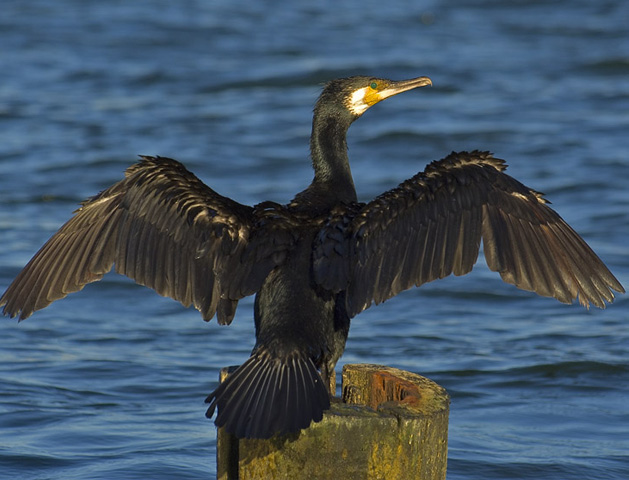
Cormorants nesting
They are coastal rather than oceanic birds, and some have colonised
inland waters - indeed, the original ancestor of cormorants seems
to have been a fresh-water bird, judging from the habitat of the most
ancient lineage. They range around the world, except for the central
Pacific islands.
All are fish-eaters, dining on small eels, fish, and even water snakes.
They dive from the surface, though many species make a characteristic
half-jump as they dive, presumably to give themselves a more streamlined
entry into the water. Under water they propel themselves with their
feet. Some cormorant species have been found, using depth gauges,
to dive to depths of as much as 45 metres.
After fishing, cormorants go ashore, and are frequently seen holding
their wings out in the sun. All cormorants have preen gland secretions
that are used ostensibly to keep the feathers waterproof. Some sources,state
that cormorants have waterproof feathers while others say that they
have water permeable feathers. Still others suggests that the outer
plumage absorbs water but does not permit it to penetrate the layer
of air next to the skin. The wing drying action is seen even in the
flightless cormorant but commonly in the Antarctic shags and red-legged
cormorants. Alternate functions suggested for the spread-wing posture
include that it aids thermoregulation digestion, balances the bird
or indicates presence of fish. A detailed study of the Great Cormorant
concludes that it is without doubtto dry the plumage.
Cormorants are colonial nesters, using trees, rocky islets, or cliffs.
The eggs are a chalky-blue colour. There is usually one brood a year.
The young are fed through regurgitation. They typically have deep,
ungainly bills, showing a greater resemblance to those of the pelicans',
to which they are related, than is obvious in the adults.
Systematics
The cormorants are a group traditionally placed within the Pelecaniformes
or, in the Sibley-Ahlquist taxonomy, the expanded Ciconiiformes. This
latter group is certainly not a natural one, and even after the tropicbirds
have been recognized as quite distinct, the remaining Pelecaniformes
seem not to be entirely monophyletic. Their relationships and delimitation
- apart from being part of a "higher waterfowl" clade which
is similar but not identical to Sibley and Ahlquist's "pan-Ciconiiformes"
- remain mostly unresolved.
Notwithstanding, all evidence agrees that the cormorants and shags
are closer to the darters and Sulidae (gannets and boobies), and perhaps
the pelicans and/or even penguins, than to all other living birds
In recent years, three preferred treatments have emerged: either to
leave all living cormorants in a single genus, Phalacrocorax, or to
split off a few species like the Imperial Shag complex (in Leucocarbo)
and perhaps the Flightless Cormorant. Alternatively, the genus may
be disassembled altogether and in the most extreme case be reduced
to the Great, White-breasted and Temminck's Cormorants.
Pending a thorough review of the Recent and prehistoric cormorants,
the single-genus approach is followed here for three reasons: First,
it is preferable to tentatively assigning genera without a robust
hypothesis. Second, it makes it easier to deal with the fossil forms,
the systematic treatment of which has been no less controversial than
that of living cormorants and shags. Third, this scheme is also used
by the IUCN, making it easier to incorporate data on status and conservation.
In accordance with the treatment there, the Imperial Shag complex
is here left unsplit too, but the King Shag complex is split up.
Several evolutionary groups are still recognizable. However, combining
the available evidence suggests that there has also been a great deal
of convergent evolution; for example the "cliff shags" are
a convergent paraphyletic group. The proposed division into Phalacrocorax
sensu stricto (or subfamily Phalacrocoracinae) "cormorants"
and Leucocarbo sensu lato (or Leucocarboninae) "shags" does
indeed have some degree of merit - though not as originally intended
- but fails to account for basal lineages and the fact that the entire
family cannot be clearly divided at present beyond the superspecies
or species-complex level. The resolution provided by the mtDNA 12S
rRNA and ATPase subunits 6 and 8 sequence datais not sufficient to
properly resolve several groups to satisfaction; in addition, many
species remain unsampled, the fossil record has not been integrated
in the data, and the effects of hybridization - known in some Pacific
species especially - on the DNA sequence data are unstudied.
Species in HBW sequence
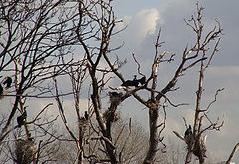
Cormorant (species unknown) begins its dive
Immature Phalacrocorax atriceps albiventer
This sequence follows the Handbook of Birds of the World
• Double-crested Cormorant or White-crested Cormorant, Phalacrocorax
auritus
• Neotropic Cormorant or Olivaceous Cormorant, Phalacrocorax
brasilianus (or Phalacrocorax olivaceus)
• Little Black Cormorant, Phalacrocorax sulcirostris
• Great Cormorant or Black Shag, Phalacrocorax carbo
• White-breasted Cormorant, Phalacrocorax lucidus
• Indian Cormorant, Phalacrocorax fuscicollis
• Cape Cormorant, Phalacrocorax capensis
• Socotra Cormorant, Phalacrocorax nigrogularis
• Wahlberg's Cormorant or Bank Cormorant, Phalacrocorax neglectus
• Temminck's Cormorant or Japanese Cormorant, Phalacrocorax
capillatus
• Brandt's Cormorant, Phalacrocorax penicillatus
• Spectacled Cormorant, Phalacrocorax perspicillatus - extinct
(c.1850)
• Common Shag, Phalacrocorax aristotelis
• Pelagic Cormorant or Baird's Cormorant, Phalacrocorax pelagicus
• Red-faced Cormorant, Phalacrocorax urile
• Rock Shag, Phalacrocorax magellanicus
• Guanay Cormorant, Phalacrocorax bougainvillii
• Pied Cormorant or Yellow-faced Cormorant, Phalacrocorax varius
• Black-faced Cormorant, Phalacrocorax fuscescens
• King Shag or Rough-faced Shag, Phalacrocorax carunculatus
• Stewart Island Shag, Phalacrocorax chalconotus
• Chatham Shag, Phalacrocorax onslowi
• Auckland Shag, Phalacrocorax colensoi
• Campbell Shag, Phalacrocorax campbelli
• Bounty Shag, Phalacrocorax ranfurlyi
• Imperial Shag or Blue-eyed Shag, Phalacrocorax atriceps
o White-bellied Shag, Phalacrocorax atriceps albiventer
• Antarctic Shag, Phalacrocorax bransfieldensis
• South Georgia Shag, Phalacrocorax georgianus
• Heard Shag, Phalacrocorax nivalis
• Crozet Shag, Phalacrocorax melanogenis
• Kerguelen Shag, Phalacrocorax verrucosus
• Macquarie Shag, Phalacrocorax purpurascens
• Red-footed Shag, Phalacrocorax gaimardi
• Spotted Shag Phalacrocorax punctatus
• Pitt Cormorant or Featherstone's Shag Phalacrocorax featherstoni
• Little Pied Cormorant, Phalacrocorax melanoleucos
• Long-tailed Cormorant, Phalacrocorax africanus
• Crowned Cormorant, Phalacrocorax coronatus
• Little Cormorant, Phalacrocorax niger
• Pygmy Cormorant, Phalacrocorax pygmaeus
• Flightless Cormorant, Phalacrocorax harrisi
Species in phylogenetic sequence
The peculiar Red-footed Shag (Phalacrocorax gaimardi)
This list attempts to follow a phylogenetic order. If the distinction
into subfamilies would be upheld, the "blue-eyed" and related
species would probably be the Leucocarboninae, and the groups that
follow them the Phalacrocoracinae. The first two lineages (and possibly
the Flightless Cormorant) are basal and cannot be assigned to either
subfamily.
Basal lineage 1: "Microcormorants", proposed genus Microcarbo
or Halietor ("Phalacrocoracinae"); the former genus name
would be valid.
Small, short-billed subtropical to tropical marine and freshwater
species from the Old World and Australia. They have black feet and
almost all lack significant white feathers. They often have a diminutive
frontal tuft.
• Little Pied Cormorant, Phalacrocorax melanoleucos
• Long-tailed Cormorant, Phalacrocorax africanus
• Crowned Cormorant, Phalacrocorax coronatus
• Little Cormorant, Phalacrocorax niger
• Pygmy Cormorant, Phalacrocorax pygmaeus
Basal lineage 2: Red-footed Shag. Included in Leucocarbo or Stictocarbo
("Leucocarboninae")
Pacific coast of South America. This species apparently has no close
living relatives. It has a highly apomorphic color pattern: naked
red base of bill, red feet, and a white neck spot, and it is crestless.
It seems to be convergent in some aspects with the punctatus superspecies.
What seems sure by now is that this species must be placed in a distinct
monotypic genus Poikilocarbo in almost any case, if any species are
split from Phalacrocorax at all.
• Red-footed Shag, Phalacrocorax gaimardi
The Double-crested Cormorant's crests are normally not visible
Two Double-crested Cormorant and one fish
Blue-eyed shags and relatives: variously placed in Euleucocarbo, Hypoleucos,
Leucocarbo, Notocarbo and Stictocarbo ("Leucocarboninae")
This reasonably well-supported marine clade contains 3 lineages:
1. One containing American species which are black-footed, black-plumaged,
and have yellow skin at the base of the bill as well as white display
crests behind the eyes in breeding plumage. They occur in marine and
freshwater habitats. If considered a genus, they would get the name
Dilophalieus.
2. The Rock Shag from southern South America with red skin at the
bill base, pink feet, a frontal crest, and an apomorphic white ear-spot
3. A group of numerous close-knit forms from southern Pacific and
subantarctic waters which are white below with pink feet but otherwise
quite varying in appearance. It contains the King and Imperial complexes
and the Guanay Cormorant. Almost all have some amount of white on
the upperwing coverts, frontal crests, and blue eye-rings. The crested
shags with yellow warts in front of the eyes belong to this group.
The genus name Leucocarbo would apply to either this group, or the
entire clade.
• Double-crested Cormorant or White-crested Cormorant, Phalacrocorax
auritus
• Neotropic Cormorant or Olivaceous Cormorant, Phalacrocorax
brasilianus
• Rock Shag, Phalacrocorax magellanicus
Guanay Cormorant, Phalacrocorax bougainvillii
• Imperial Shag or Blue-eyed Shag, Phalacrocorax atriceps
o White-bellied Shag, Phalacrocorax (atriceps) albiventer
o Antarctic Shag, Phalacrocorax (atriceps) bransfieldensis
o South Georgian Shag, Phalacrocorax (atriceps) georgianus
o Heard Shag, Phalacrocorax (atriceps) nivalis
o Crozet Shag, Phalacrocorax (atriceps) melanogenis
o Kerguelen Shag, Phalacrocorax (atriceps) verrucosus
o Macquarie Shag, Phalacrocorax (atriceps) purpurascens
• Guanay Cormorant, Phalacrocorax bougainvillii
• King Shag or Rough-faced Shag, Phalacrocorax carunculatus
• Stewart Island Shag, Phalacrocorax chalconotus
• Chatham Shag, Phalacrocorax onslowi
• Auckland Shag, Phalacrocorax colensoi
• Campbell Shag, Phalacrocorax campbelli
• Bounty Shag, Phalacrocorax ranfurlyi
Brandt's
Cormorant (Phalacrocorax penicillatus) - crestless, but with ornamental
plumes
North Pacific shags: spread between Compsohalieus ("Phalacrocoracinae")
and Stictocarbo ("Leucocarboninae"). If a distinct genus,
the former name would apply
A well-supported marine group ranging from the Bering Strait to
California. They are black-footed and have white ornamental plumes
strewn about the head and neck in breeding plumage. They tend to
have prominent double crests.
• Brandt's Cormorant, Phalacrocorax penicillatus
• Spectacled Cormorant, Phalacrocorax perspicillatus - extinct
(c.1850)
• Pelagic Cormorant or Baird's Cormorant, Phalacrocorax pelagicus
• Red-faced Cormorant, Phalacrocorax urile
Common Shag lineage: formerly in Compsohalieus ("Phalacrocoracinae")
and Stictocarbo ("Leucocarboninae")
Black-footed smallish marine shags of Europe and southern Africa.
Wahlberg's Cormorant is very tentatively placed here; it seems anatomically
more similar to the P. fuscscens, but the more informative characters
- the combination of frontal crest and lack of extensive naked skin
at bill base in mid-sized Old World species - seem to place it here.
If this is correct, they are probably very distantly related due
to biogeography.
• Common Shag, Phalacrocorax aristotelis
• Wahlberg's Cormorant or Bank Cormorant, Phalacrocorax neglectus
- tentatively placed here
Indian Ocean group: spread between Hypoleucos and Leucocarbo ("Leucocarboninae")
and Compsohalieus ("Phalacrocoracinae"). Hypoleucos would
be the correct genus name if they were split off.
Little
Black Cormorant, Phalacrocorax sulcirostris
A group of black-footed species occurring in tropical coastal or
inland habitat between the Persian Gulf and Australia. Most species
are tentatively assigned here, based on the combination of range,
crestlessness, size, general lack of naked skin ornaments and the
presence of some amount of white feathering in the ear region at
least in breeding plumage. This clade is not too well supported,
but this may be because the two presumed members included in recent
researches are quite dissimilar; the three unstudied ones are very
similar to one or the other
•
Little Black Cormorant, Phalacrocorax sulcirostris
• Indian Cormorant, Phalacrocorax fuscicollis - tentatively
placed here
• Socotran Cormorant, Phalacrocorax nigrogularis - tentatively
placed here
• Pied Cormorant or Yellow-faced Cormorant, Phalacrocorax
varius
• Black-faced Cormorant, Phalacrocorax fuscescens - tentatively
placed here
Spotted group: placed in Stictocarbo ("Leucocarboninae");
indeed, they would be the only members of this possibly distinct
genus
A superspecies of the New Zealand region. Peculiarly apomorphic,
with yellowish legs, prominent double crests, white ornamental plumes
on the neck, a grey belly and spotted wings.
• Spotted Shag Phalacrocorax punctatus
• Pitt Cormorant or Featherstone's Shag Phalacrocorax featherstoni
Cape Cormorant: sometimes placed in Leucocarbo ("Leucocarboninae")
Highly plesiomorphic among its relatives; a species from the southern
coasts of Africa. It is apparently close to the common ancestor
of the next group and, perhaps apart from the all-black plumage,
looks almost identical to that long-extinct bird.
• Cape Cormorant, Phalacrocorax capensis
Great
Cormorant (Phalacrocorax carbo) drying its wings
True cormorants: these would be retained in Phalacrocorax no matter
how the cormorants and shags are split up
They occur from the western Atlantic through the Old World into
Australia, usually but not always in marine and temperate to subtropical
habitat. They are characteristic, being large, with white cheek
and thigh patches, ornamental plumes in the neck, a yellow naked
bill base, black feet, and a shaggy nape crest.
• Great Cormorant, Phalacrocorax carbo
• White-breasted Cormorant, Phalacrocorax lucidus
• Temminck's Cormorant or Japanese Cormorant, Phalacrocorax
capillatus
Incertae sedis: Occasionally placed in the monotypic genus Nannopterum,
alternatively Compsohalieus ("Phalacrocoracinae") or Leucocarbo
("Leucocarboninae")
The relationships of this species remain unresolved. Confined to
the Galapagos Islands, its wings have been reduced by evolution
to tiny size. It is extremely apomorphic due to its flightlessness,
and its plumage is entirely nondescript. It might be a derivative
of the North Pacific lineage, or even the only cormorant somewhat
closer to the Red-footed Shag.
• Flightless Cormorant, Phalacrocorax harrisi
evolution and fossil record
Cormorants seem to be a very ancient group, with similar ancestors
reaching all the way back to the time of the dinosaurs. In fact,
the very earliest known modern bird, Gansus yumenensis, had essentially
the same structure, although it was not a cormorant per se. The
details of the evolution of the cormorant are mostly unknown. Even
the technique of using the distribution and relationships of a species
to figure out where it came from, biogeography, usually very informative,
does not give very specific data for this probably rather ancient
and widespread group. However, the closest living relatives of the
cormorants and shags are the other families of the suborder Sulae—darters
and gannets and boobies—which have a primarily Gondwanan distribution.
Hence, at least the modern diversity of Sulae probably originated
in the southern hemisphere.
While the leucocarbonines are almost certainly of southern Pacific
origin—possibly even the Antarctic which, at the time when
cormorants evolved. was not yet ice-covered—all that can be
said about the phalacrocoracines is that they are most diverse in
the regions bordering the Indian Ocean, but generally occur over
a large area.
Similarly, the origin of the family is shrouded in uncertainties.
Some Late Cretaceous fossils have been proposed to belong with the
Phalacrocoracidae:
A scapula from the Campanian-Maastrichtian boundary, about 70 mya
(million years ago), was found in the Nemegt Formation in Mongolia;
it is now in the PIN collection.[19] It is from a bird roughly the
size of a Spectacled Cormorant, and quite similar to the corresponding
bone in Phalacrocorax. A Maastrichtian (Late Cretaceous, c.66 mya)
right femur, AMNH FR 25272 from the Lance Formation near Lance Creek,
Wyoming, is sometimes suggested to be the second-oldest record of
the Phalacrocoracidae; this was from a rather smaller bird, about
the size of a Long-tailed Cormorant.
As the Early Oligocene "Sula" ronzoni cannot be assigned
to any of the suloid families—cormorants and shags, darters,
and gannets and boobies—with certainty, the best interpretation
is that the Phalacrocoracidae diverged from their closest ancestors
in the Early Oligocene, perhaps some 30 million years ago, and that
the Cretaceous fossils represent ancestral suloids, "pelecaniforms"
or "higher waterbirds"; at least the last lineage is generally
believed to have been already distinct and undergoing evolutionary
radiation at the end of the Cretaceous. What can be said with near
certainty is that AMNH FR 25272 is from a diving bird that used
its feet for underwater locomotion; as this is liable to result
in some degree of convergent evolution and the bone is missing undisputable
neornithine features, it is not entirely certain that the bone is
correctly referred to this group.
During the late Paleogene, when the family presumably originated,
much of Eurasia was covered by shallow seas, as the Indian Plate
finally attached to the mainland. Lacking a detailed study, it may
well be that the first "modern" cormorants were small
species from eastern, south-eastern or southern Asia, possibly living
in freshwater habitat, that dispersed due to tectonic events. Such
a scenario would account for the present-day distribution of cormorants
and shags and is not contradicted by the fossil record; as remarked
above, a thorough review of the problem is not yet available.
Double-crested
Cormorant in its natural habitat.
One distinct genus of prehistoric cormorants is generally accepted
today, if Phalacrocorax is used for all living species:
• †Nectornis (Late Oligocene?/Early Miocene of C Europe
- Middle Miocene of Bes-Konak, Turkey) - includes Oligocorax miocaenus
Oligocorax appears to be paraphyletic - the European species have
been separated in Nectornis, and the North American ones are placed
in the expanded Phalacrocorax. A Late Oligocene fossil cormoran
foot from Enspel (Germany), sometimes placed herein, would then
be referable to Nectornis if it proves not to be too distinct. All
these early European species might belong to the basal group of
"microcormorants", as they conform with them in size and
seem to have inhabited the same habitat: subtropical coastal or
inland waters.
The supposed Late Pliocene/Early Pleistocene "Valenticarbo"
is a nomen dubium and given its recent age probably not a separate
genus.
The remaining species are, in accordance with the scheme used in
this article, all placed in the modern genus Phalacrocorax:
• Phalacrocorax marinavis (Oligocene ?-? Early Miocene of
Oregon, USA) - formerly Oligocorax
• Phalacrocorax littoralis (Late Oligocene/Early Miocene of
St-Gérand-le-Puy, France) - formerly Oligocorax, might belong
into Nectornis
• Phalacrocorax intermedius (Early - Middle Miocene of C Europe)
- includes P. praecarbo, Ardea/P. brunhuberi and Botaurites avitus
• Phalacrocorax macropus (Early Miocene ?-? Pliocene of NW
USA)
• Phalacrocorax ibericus (Late Miocene of Valles de Fuentiduena,
Spain)
• Phalacrocorax lautus (Late Miocene of Golboçica,
Moldavia)
• Phalacrocorax serdicensis (Late Miocene of Hrabarsko, Bulgaria)
• Phalacrocorax femoralis (Modelo Late Miocene/Early Pliocene
of WC North America) - formerly Miocorax
• Phalacrocorax sp. (Late Miocene/Early Pliocene of Lee Creek
Mine, USA)
• Phalacrocorax longipes (Late Miocene - Early Pliocene of
the Ukraine) - formerly Pliocarbo
• Phalacrocorax goletensis (Early Pliocene ?-? Early Pleistocene
of Mexico)
• Phalacrocorax wetmorei (Bone Valley Early Pliocene of Florida)
• Phalacrocorax sp. (Bone Valley Early Pliocene of Polk County,
Florida, USA)
• Phalacrocorax leptopus (Juntura Early/Middle Pliocene of
Juntura, Malheur County, Oregon, USA)
• Phalacrocorax idahensis (Middle Pliocene ?-? Pleistocene
of Idaho, USA)
• Phalacrocorax destefanii[verification needed] (Late Pliocene
of Italy) - formerly Paracorax
• Phalacrocorax filyawi (Pinecrest Late Pliocene of Florida,
USA) - may be P. idahensis
• Phalacrocorax kumeyaay (San Diego Late Pliocene of California)
• Phalacrocorax macer (Late Pliocene of Idaho, USA)
• Phalacrocorax mongoliensis (Late Pliocene of W Mongolia)
• Phalacrocorax rogersi (Late Pliocene -? Early Pleistocene
of California, USA)
• Phalacrocorax kennelli (San Diego Pliocene of California)
• Phalacrocorax sp. "Wildhalm"[verification needed]
(Pliocene) - may be same as P. longipes
• Phalacrocorax chapalensis (Late Pliocene/Early Pleistocene
of Jalisco, Mexico
• Phalacrocorax gregorii (Late Pleistocene of Australia) -
possibly not a valid species
• Phalacrocorax vetustus (Late Pleistocene of Australia) -
formerly Australocorax, possibly not a valid species
• Phalacrocorax reliquus
• Phalacrocorax sp. (Sarasota County, Florida) - may be P.
filawyi/idahensis
The former "Phalacrocorax" (or "Oligocorax")
mediterraneus is now considered to belong to the bathornithid Paracrax
antiqua. "P." subvolans was actually a darter (Anhinga).
Cormorant fishing
A
Chinese fisherman with his two cormorants
Japanese
man displaying ancient cormorant night fishing technique.
Main article: Cormorant fishing
Humans have historically exploited cormorants' fishing skills, in
China, Japan, and Macedonia, where they have been trained by fishermen.
A snare is tied near the base of the bird's throat, which allows
the bird only to swallow small fish. When the bird captures and
tries to swallow a large fish, the fish is caught in the bird's
throat. When the bird returns to the fisherman's raft, the fisherman
helps the bird to remove the fish from its throat. The method is
not as common today, since more efficient methods of catching fish
have been developed.
In Japan, cormorant fishing is called ukai (??). Traditional forms
of ukai can be seen on the Nagara River in the city of Gifu, Gifu
Prefecture, where cormorant fishing has continued uninterrupted
for 1300 years, or in the city of Inuyama, Aichi. In Guilin, China,
cormorant birds are famous for fishing on the shallow Lijiang River.
In Gifu, the Japanese Cormorant (P. capillatus) is used; Chinese
fishermen often employ Great Cormorants (P. carbo).
Cormorants in human culture
Moche
Cormorant. Larco Museum Collection Lima, Peru.
• The Moche people of ancient Peru worshipped nature. They
placed emphasis on animals and even depicted cormorants in their
art.
• Cormorants feature quite commonly in heraldry and medieval
ornamentation, usually in their "wing-drying" pose, which
was seen as representing the Christian cross. For example, the Norwegian
municipalities of Røst, Loppa and Skjervøy have cormorants
in their coat-of-arms. The species depicted in heraldry is most
likely to be the Great Cormorant, the most familiar species in Europe.
• In 1853, a woman wearing a dress made of cormorant feathers
was found on San Nicolas Island, off the southern coast of California.
She had sewn the feather dress together using whale sinews. She
is known as the Lone Woman of San Nicolas and was later baptized
"Juana Maria" (her original name is lost). The woman had
lived alone on the island for 18 years before being rescued.
• Christopher Isherwood in his comic verse The Common Cormorant
was evidently unclear on the differences between cormorants and
shags, and his information about the birds' nesting habits should
not be relied on either
• In addition to those mentioned above, the bird has inspired
numerous writers, including Amy Clampitt, who wrote a poem called
"The Cormorant in its Element". Which species she was
referring to is not obvious, since all members of the family share
the characteristic behavioural and morphological features that the
poem celebrates. The combination of "slim head [...] vermilion-strapped"
and "big black feet" perhaps points at the Pelagic Cormorant,
which is the only species occurring in the temperate U.S. with these
features.
• The cormorant is mentioned in Leviticus 11:17, Deuteronomy
14:17, Isiah 34:11 as an "abomination" of birds not to
be eaten, containing the Lord's vengeance, and Zephaniah 2:14, as
the desolation resulting from that vengeance.
• The cormorant as a symbol of deception and greed is described
in Milton's Paradise Lost, sitting on the Tree of Life, as an image
of Satan entering Paradise in disguise before tempting Eve.
• There is a cormorant portrayed in the first of the fictional
paintings by Jane Eyre in Charlotte Bronte's novel, representing
Blanche Ingram.
• The mythical Liver Bird symbol of Liverpool is commonly
thought to be a cross between an eagle and a comorant
:::::::::::::::::::::::::::::::::::::::::::::::::::::::::::::::::::::::::::::::::::::::::::::::::::::::::::::::::::::::::::::::::::::::::::::::::::::::::::::::::::::::::::::::::::::::::::::::::::::::::::::::::::::::::::::::::::
Cotton
Pygmy Goose
Cotton
Pygmy Goose |
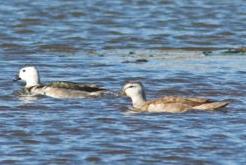
Male (behind), and female, race albipennis |
Conservation
status |
Least
Concern (IUCN 3.1)[1] |
Scientific
classification |
Kingdom: |
Animalia |
Phylum: |
Chordata |
Class: |
Aves |
Order: |
Anseriformes |
Family: |
Anatidae |
Genus: |
Nettapus |
Species: |
N.coromandelianus |
| Binomial
name |
Nettapus
coromandelianus
Gmelin, 1789 |
| Subspecies |
•
N. c. coromandelianus
(Lesser Cotton Pygmy Goose)
• N. c. albipennis
(Greater Cotton Pygmy Goose) |
The Cotton Pygmy Goose or the Cotton Teal,Nettapus coromandelianus
is a small perching duck which breeds in India, Pakistan, southeast
Asia and south to northern Australia. It is locally known as Girri,
Girria, Girja (Hindi); Gurgura (Etawah); Bali hans (Bengal); Bhullia
hans (Bangladesh); Dandana (Orissa); Ade, Atla (Ratnagiri); Naher,
Keeke, Chuwa (Nowgong, Assam); Baher, Kararhi (Sind, Pakistan).
Description
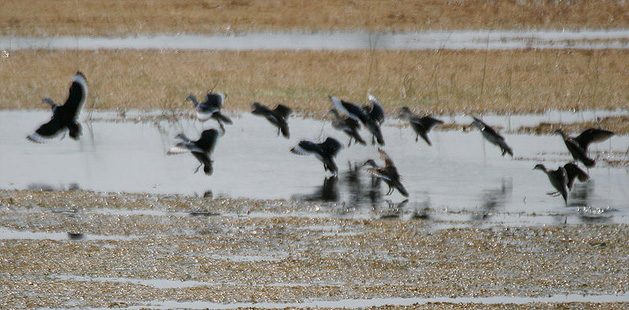
Male
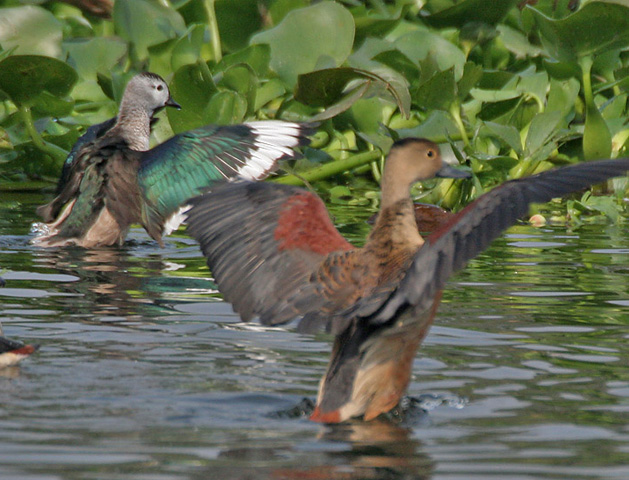
Females resting with a Whiskered Tern
Small examples are the smallest waterfowl on earth, at as little
as 160 g (5.5 oz) and 26 cm (10.5 in). White predominates in this
bird's plumage. Bill short, deep at base, and goose-like.
Male in breeding plumage is glossy blackish green crown, with white
head, neck, and underparts; a prominent black collar and white wing-bar.
Rounded head and short legs. In flight, the wings are green with
a white band, making the male conspicuous even amongst the huge
flying flocks of the Lesser Whistling Duck, which share the habitat.
Female paler, without either black collar and only a narrow or nonexistent
strip of white wing-bar. In non-breeding plumage (eclipse) male
resembles female except for his white wing-bar. Flocks on water
bodies (jheels), etc.
Call: A peculiar clucking, uttered in flight
Distribution
It is largely resident, apart from dispersion in the wet season,
but Chinese birds winter further south. It nests in tree holes,
laying 8-15 eggs.
This is an abundant species in Asia, although the slightly larger
Australian race appears to be declining in numbers.
Found on all still freshwater lakes (jheels), rain-filled ditches,
inundated paddy fields, irrigation tanks, etc. Becomes very tame
on village tanks wherever it is unmolested and has become inured
to human proximity. Swift on the wing, and can dive creditably on
occasion.
Food
Chiefly seeds and vegetable matter, especially water lilies; also
insects, crustaceans, etc.
Nesting
Season- July to September (SW. monsoon). Nest- a natural hollow
in a tree-trunk standing in or near water, sometimes lined with
grass, rubbish and feathers. Eggs- 6 to 12, ivory white
:::::::::::::::::::::::::::::::::::::::::::::::::::::::::::::::::::::::::::::::::::::::::::::::::::::::::::::::::::::::::::::::::::::::::::::::::::::::::::::::::::::::::::::::::::::::::::::::::::::::::::::::::::::::::::::::::::
Darter
Darters
Fossil range: Early Miocene - Recent |
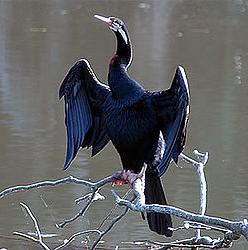
Male Oriental Darter |
Scientific
classification |
| Kingdom |
Animalia |
| Phylum: |
Chordata |
| Class: |
Aves |
| Subclass: |
Neornithes |
| Infraclass: |
Neoaves |
| Order: |
Pelecaniformes |
| Suborder: |
Sulae |
| Family: |
Anhingidae
Reichenbach, 1849 |
| Genus: |
Anhinga
Brisson, 1760 |
Species |
Anhinga
anhinga
Anhinga melanogaster
Anhinga rufa
Anhinga novaehollandiae
(but see article text) |
| Synonyms |
| Plotus |
The darters or snake-birds are birds in the family
Anhingidae. There are four living species, one of which is
near-threatened. The darters are frequently referred to as snake-birds
because of their long thin neck, which gives a snake-like appearance
when they swim with their bodies submerged.
The darters are large birds with sexually dimorphic plumage. The males
have black and dark brown plumage, an erectile crest on the nape and
a larger bill than the female. The females have a much paler plumage
especially on the neck and underparts. Both have grey stippling on
long scapulars and upper wing coverts. The sharply pointed bill has
serrated edges. The darters have completely webbed feet, and their
legs are short and set far back on the body. Their plumage is somewhat
permeable, like that of cormorants, and they spread their wings to
dry after diving. Vocalizations include a clicking or rattling when
flying or perching. During breeding adults sometimes have caw or hissing
calls.
Range
Darters are circum-equatorial, tropical or subtropical. They inhabit
either fresh or brackish water and can be found in lakes, rivers,
marshes, swamps, estuaries, bays, lagoons and mangrove swamps. They
tend to gather in flocks sometimes up to about 100 birds but are highly
territorial when breeding. Most are sedentary and do not migrate,
however the populations at extreme distributions may migrate. The
Oriental Darter is near-threatened species.Habitat destruction along
with other human interferences is among the main reasons for a declining
population.
Food and feeding
Darters feed mainly on fish. They use their sharply pointed bill to
spear their prey when they dive; this is how they get the name darter.
Their ventral keel is present on the 5-7 vertebrae which allows for
muscles to attach so that they are able to project their bill forward
like a spear. They also eat amphibians such as frogs and newts, reptiles
such as snakes and turtles and invertebrates such as insects, shrimp
and mollusks. These birds use their feet to move underwater and quietly
stalk and ambush their prey. They then stab the prey, such as a fish,
and bring them to the surface where they toss it into the air and
catch and swallow it.
Breeding
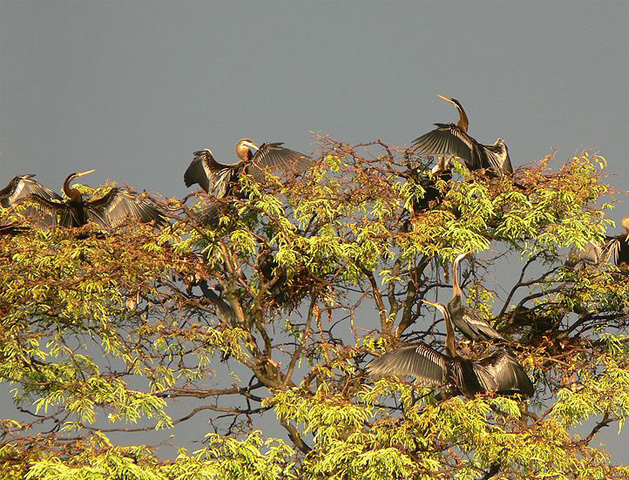
Anhinga melanogaster "snake birds" nesting
The darters are monogamous and pair bond during the breeding season.
There are many different types of displays used for mating including
male displays to attract the female, greeting displays between the
male and female and pair bonding displays between the pairs. Also
during breeding, their small gular sac changes from pink or yellow
to black and the bare facial skin turns to turquoise from a yellow
or yellow-green color. They usually breed in colonies.
Breeding can be seasonal or year round and varies by geographic range.
The nests are made of twigs and are built in trees or reeds, often
near water. The clutch size is two to six eggs (usually about 4) of
a pale green color and the eggs are incubated for 25 to 30 days. The
eggs hatch asynchronously. Bi-parental care is given and the young
are considered altricial. They reach sexual maturity by about 2 years.
These birds generally live to around 9 years. Systematics
and evolution
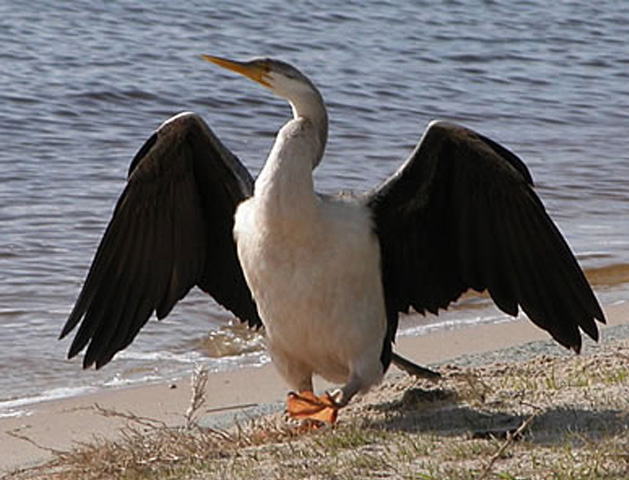
Female
Oriental Darter
This family is very closely related to the other families in the
Pelecaniformes suborder Sulae, i.e. the cormorants and shags and
the gannets and boobies. Cormorants and anhingas are extremely similar
as regards their body and leg skeletons, showing that they are closely
related. In fact, several anhinga fossils were initially believed
to be cormorants or shags (see below for examples).
There are four living species of darters recognized, all in the
genus Anhinga, although the Old World ones are often lumped together
as subspecies of A. melanogaster:
• Anhinga, Anhinga anhinga
• Oriental Darter, Anhinga melanogaster
• African Darter, Anhinga rufa
• Australian Darter, Anhinga novaehollandiae
Extinct "species" from Mauritius and Australia known only
from bones were described as Anhinga nana ("Mauritian Darter")
and Anhinga parva, but they were misidentifications of bones of
the Long-tailed Cormorant and the Little Pied Cormorant, respectively.
In the former case, however, they might belong to an extinct subspecies
which would have to be called Phalacrocorax africanus nanus (Mauritian
Cormorant) - quite ironically, as nanus means "dwarf"
and the remains are larger than those of the geographically closest
population of the Long-tailed Cormorant.
The darters are known since the Early Miocene. The diversity was
highest in the Americas; a number of prehistoric species and genera
known only from fossils have been described. The aptly named Macranhinga,
Meganhinga and Giganhinga represent very large and at least partly
flightless forms:
• Meganhinga (Early Miocene of Chile)
• Macranhinga (Middle/Late Miocene -? Early Pliocene of SC
South America)
• Giganhinga (Late Pliocene/Early Pleistocene of Uruguay)
• Anhingidae gen. et sp. indet. (Middle/Late Miocene of Paraná,
Argentina)
Prehistoric members of Anhinga are:
• Anhinga subvolans (Early Miocene of Thomas Farm, USA) -
formerly in Phalacrocorax
• Anhinga cf. grandis (Middle Miocene of Colombia -? Late
Pliocene of SC South America)
• Anhinga sp. (Sajóvölgyi Middle Miocene of Mátraszõlõs,
Hungary)
• Anhinga fraileyi (Late Miocene -? Early Pliocene of S South
America)
• Anhinga minuta (Solimões Late Miocene/Early Pliocene
of SC South America)
• Anhinga pannonica (Late Miocene/Early Pliocene of Tatarus-Brusturi,
Hungary ?and Tunisia, East Africa, Pakistan and Thailand - ?Sahabi
Early Pliocene of Libya)
• Anhinga grandis (Late Miocene - Kimball Late Pliocene of
USA)
• Anhinga malagurala (Allingham Early Pliocene of Charters
Towers, Australia)
• Anhinga sp. (Early Pliocene of Bone Valley, USA)
• Anhinga hadarensis (Late Pliocene/Early Pleistocene of E
Africa)
• Anhinga sp. (Early Pleistocene of Coleman, USA) - may be
same as Anhinga sp. "Bone Valley"
The Pleistocene Anhinga laticeps is a misidentified Australian Darter;
it might have been a paleosubspecies of the last ice age.
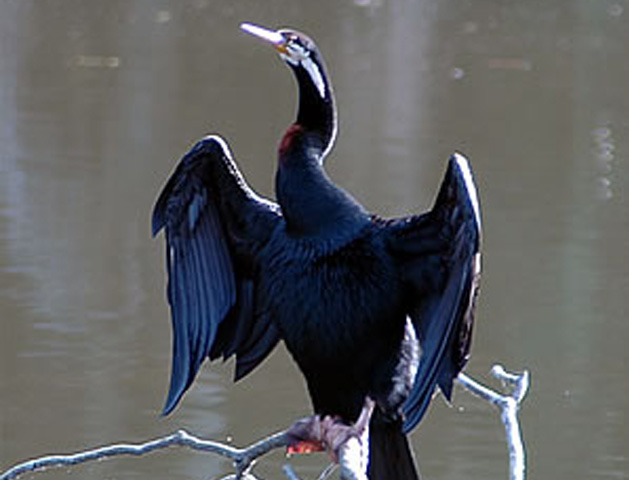
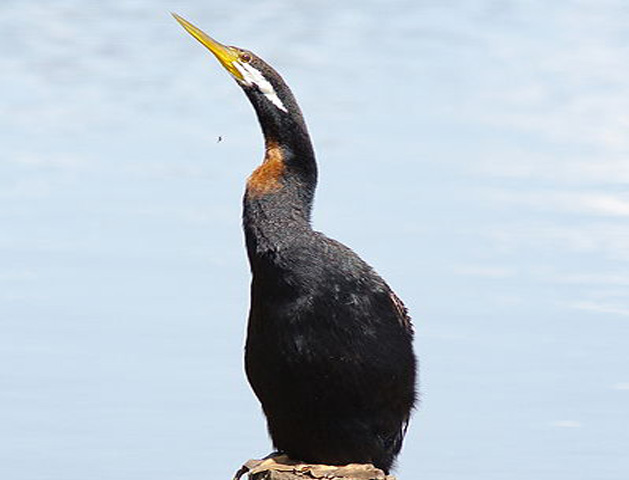
:::::::::::::::::::::::::::::::::::::::::::::::::::::::::::::::::::::::::::::::::::::::::::::::::::::::::::::::::::::::::::::::::::::::::::::::::::::::::::::::::::::::::::::::::::::::::::::::::::::::::::::::::::::::::::::::::::
Indian Pond Heron
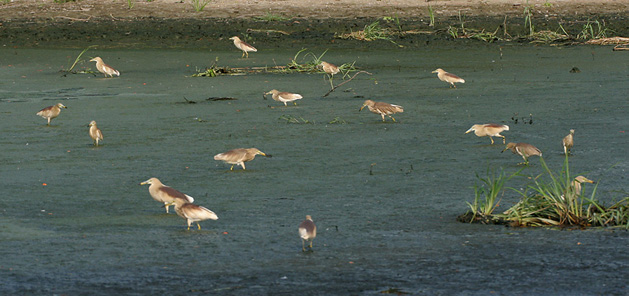
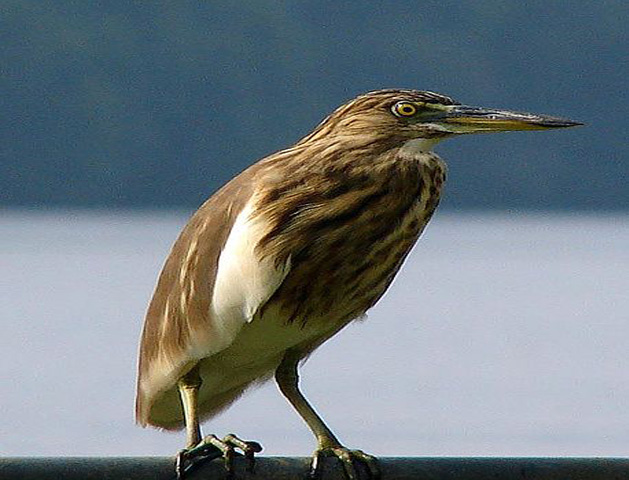
In non-breeding plumage
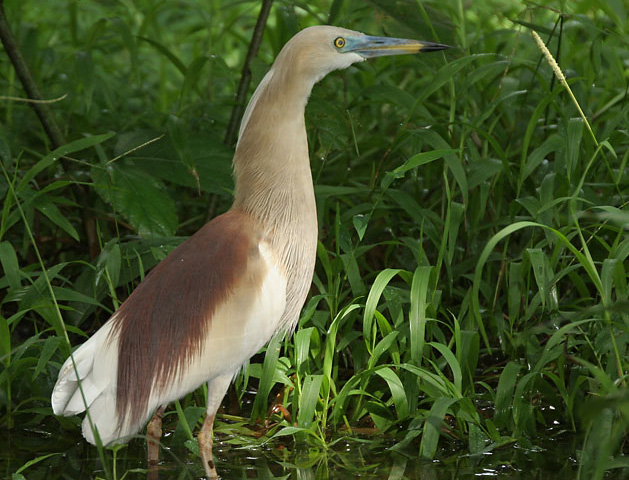
Breeding plumage
| Conservation
status |
| Least
Concern (IUCN 3.1)[1] |
| Scientific
classification |
| Kingdom: |
Animalia |
| Phylum: |
Chordata |
| Class: |
Aves |
| Order: |
Ciconiiformes |
| Family: |
Ardeidae |
| Genus: |
Ardeola |
| Species: |
A.
grayii |
| Binomial
name |
Ardeola
grayii
(Sykes, 1832) |
| Synonyms |
| Ardeola
leucoptera |
The
Indian Pond Heron (Ardeola grayii) is a small heron.
It is of Old World origins, breeding in southern Iran and east to
India, Burma and Sri Lanka.
Contents
• 1 Description
• 2 Ecology
• 3 References
• 4 =Gallery
Description
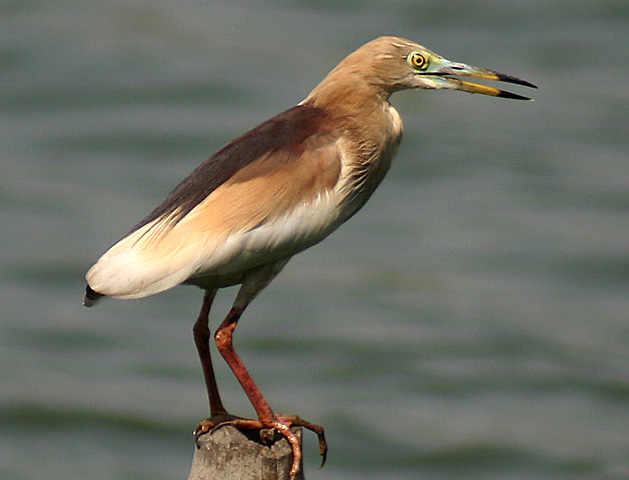
In Breeding plumage with red legs in Kolkata, West Bengal, India.
They appear stocky with a short neck, short thick bill and buff-brown
back. In summer, adults have long neck feathers. Its appearance is
transformed from their dull colours when they take to flight, when
the white of the wings makes them very prominent. It is very similar
to the Squacco Heron, Ardeola ralloides, but is darker-backed. To
the east of its range, it is replaced by the Chinese Pond Heron, Ardeola
bacchus.
During the breeding season, there are records of individuals with
red legs. The numbers do not suggest that this is a normal change
for adults during the breeding season and some have suggested the
possibility of it being genetic variants.[2][3][4][5]
Erythristic plumage has been noted.[6] The race phillipsi has been
suggested for the populations found in the Maldives, however this
is not always recognized.[7]
They are very silent but may give a harsh croak when flushed or near
their nests.[7]
This bird was first described by Colonel W. H. Sykes in 1832 and given
its scientific name in honour of John Edward Gray.
Ecology
The Indian Pond Heron's feeding habitat is marshy wetlands. They usually
feed at the edge of ponds but make extensive use of floating vegetation
such as Water hyacinth to access deeper water. They may also on occasion
swim on water or fish from air
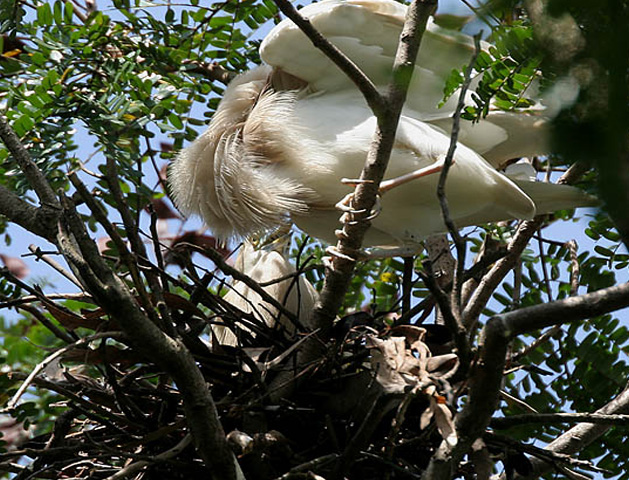
Pair at Nest in Kolkata, West Bengal, India.
They nest in small colonies, often with other wading birds, usually
on platforms of sticks in trees or shrubs. 3-5 eggs are laid.[11]
These herons feed on insects (including dragonflies[12]), fish (Barilius
noted as important in a study in Chandigarh) and amphibians.[13]
Nocturnal movements of Pond Herons have been noted along the coast
near Chennai.[14]
They are very common in India, and they can be approached very close
before they are flushed. They may also forage at garbage heaps.
They have few predators and injured birds may be taken by birds of
prey.[15]
An arbovirus "Balagodu", trematodes and several other parasites
have been isolated from the species.[16][17][18][19][20] Antibodies
to Japanese Encephalitis/West Nile Virus has been detected in Pond
Herons and Cattle Egrets from southern India.[21] Heavy metal pollution
appears to be indicated particularly in the tail feathers.[22]
Karyology studies indicate that Pond Herons have 68 chromosomes


:::::::::::::::::::::::::::::::::::::::::::::::::::::::::::::::::::::::::::::::::::::::::::::::::::::::::::::::::::::::::::::::::::::::::::::::::::::::::::::::::::::::::::::::::::::::::::::::::::::::::::::::::::::::::::::::::::
Indian
shag or Cormorant |
 |
Conservation
status |
| Least
Concern (IUCN 3.1) |
Scientific
classification |
| Kingdom: |
Animalia |
| Phylum: |
Chordata |
| Class: |
Aves |
| Order: |
Pelecaniformes |
| Family: |
Phalacrocoracidae |
| Genus: |
Phalacrocorax |
| Species: |
P.
fuscicollis |
Binomial
name |
Phalacrocorax
fuscicollis
Stephens, 1826 |
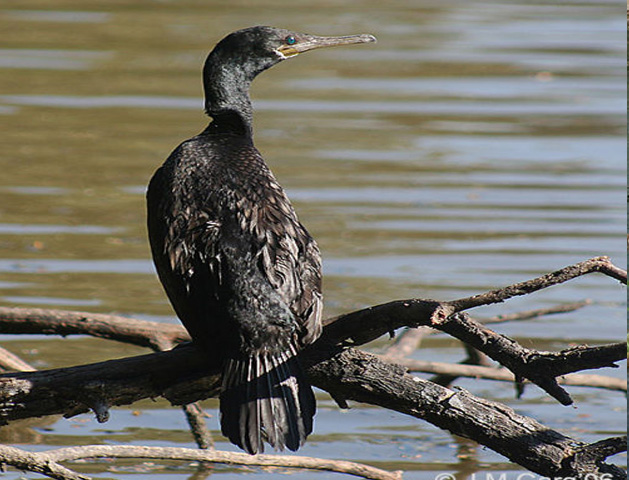
In non-breeding plumage
The Indian Cormorant (Phalacrocorax fuscicollis)
is a member of the cormorant family of seabirds. It breeds in tropical
Asia from Oman, Yemen, Pakistan, India, Sri Lanka into Southeast Asia.
It is resident but undertakes some seasonal movements.
This is a common and widespread bird species, which breeds in freshwater
wetlands. 3-6 eggs are laid in a nest in a tree.
This is a smallish, slender, cormorant with a triangular head profile.
It is 63 cm in length. Indian Cormorant is mainly black in the breeding
season, with white neck plumes and a whitish throat. The wing coverts
are silvery and it has a longish tail.
This species can be separated from the similar looking Little Cormorant
(Phalacrocorax niger) by its slender bill, more peaked appearance
to its head and lack of the glossy black plumage of the smaller bird.
It is also more gregarious and is often found in larger bodies of
water and rivers.
Sexes are similar, but non-breeding adults and juveniles are browner
and lack the neck plumes.
The Indian Cormorant can dive to considerable depths, but usually
feeds in shallow water. It frequently brings prey to the surface.
A wide variety of fish are taken.
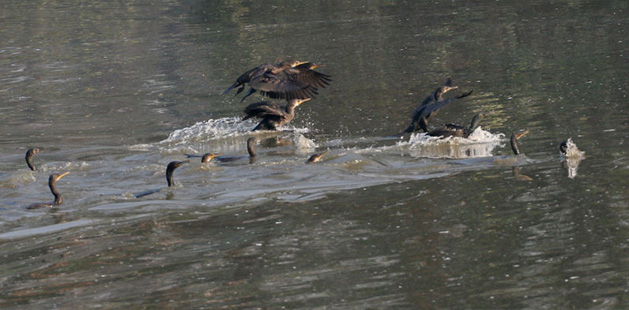
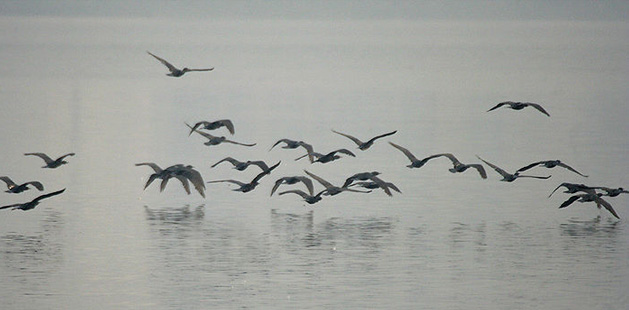
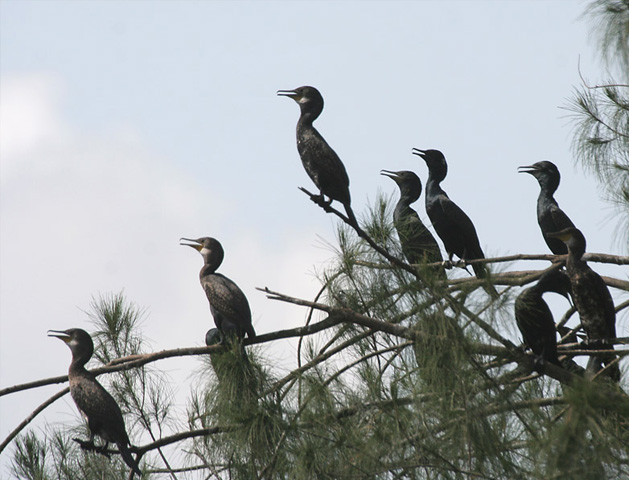
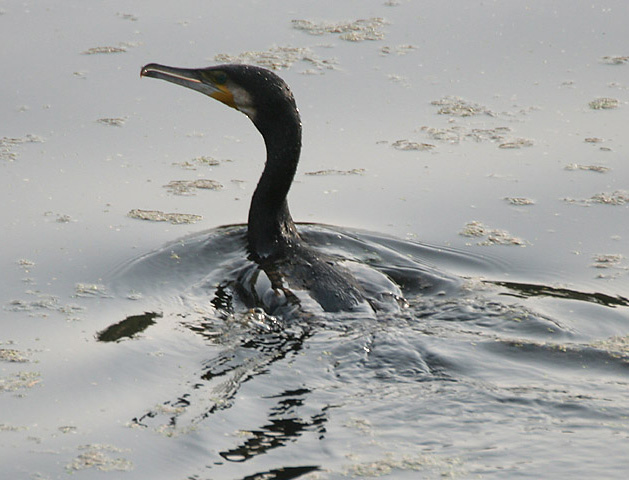
:::::::::::::::::::::::::::::::::::::::::::::::::::::::::::::::::::::::::::::::::::::::::::::::::::::::::::::::::::::::::::::::::::::::::::::::::::::::::::::::::::::::::::::::::::::::::::::::::::::::::::::::::::::::::::::::::::
Intermediate Egret

| Conservation
status |
| Least
Concern (IUCN 3.1)[1] |
| Scientific
classification |
| Kingdom: |
Animalia |
| Phylum: |
Chordata |
| Class: |
Aves |
| Order: |
Ciconiiformes
(disputed) |
| Family: |
Ardeidae |
| Genus: |
Ardea |
| Species: |
A.
intermedia |
| Binomial
name |
Ardea
intermedia
Wagler, 1827 |
| Synonyms |
Egretta
intermedia
Mesophoyx intermedia |

In Breeding plumage
The Intermediate Egret or Median, or Yellow-billed,
Egret, (Ardea intermedia) is a medium-sized heron.
It is a resident breeder from east Africa across tropical southern
Asia to Australia. It often nests in colonies with other herons, usually
on platforms of sticks in trees or shrubs. Two to five eggs are laid,
the clutch size varying with region. This species, as its scientific
name implies, is intermediate in size between the Great Egret and
smaller white egrets like the Little Egret and Cattle Egret, though
nearer to Little than Great. It is about 90 cm tall with all-white
plumage, generally dark legs and a thickish yellow bill. Breeding
birds may have a reddish or black bill, greenish yellow gape skin,
loose filamentous plumes on their breast and back, and dull yellow
or pink on their upper legs (regional variations). The sexes are similar.
The
Intermediate Egret stalks its prey methodically in shallow coastal
or fresh water, including flooded fields. It eats fish, crustaceans
and insects.
Difference from Great Egret

The non-breeding colours are similar, but the Intermediate is smaller,
with neck length a little less than body length, a slightly domed
head, and a shorter, thicker bill. The Great Egret has a noticeable
kink near the middle of its neck, and the top of its longer bill
nearly aligns with the flat top of its head. Close up, the bare
skin of the Great Egret's gape line extends in a dagger shape behind
the eye, while the Intermediate's is less pointed and ends below
the eye. The Intermediate tends to stalk upright with neck extended
forward. The Great is more patient, often adopting a sideways-leaning
"one-eyed" stance.
Difference from Little Egret
Little Egrets have yellow-soled feet. They often run after fish
in shallow water. Breeding birds have long nuptial plumes on the
back of their heads.

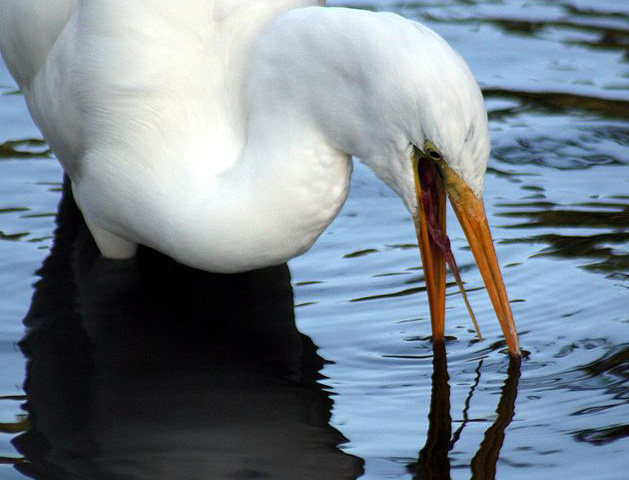


:::::::::::::::::::::::::::::::::::::::::::::::::::::::::::::::::::::::::::::::::::::::::::::::::::::::::::::::::::::::::::::::::::::::::::::::::::::::::::::::::::::::::::::::::::::::::::::::::::::::::::::::::::::::::::::::::::
Jacana
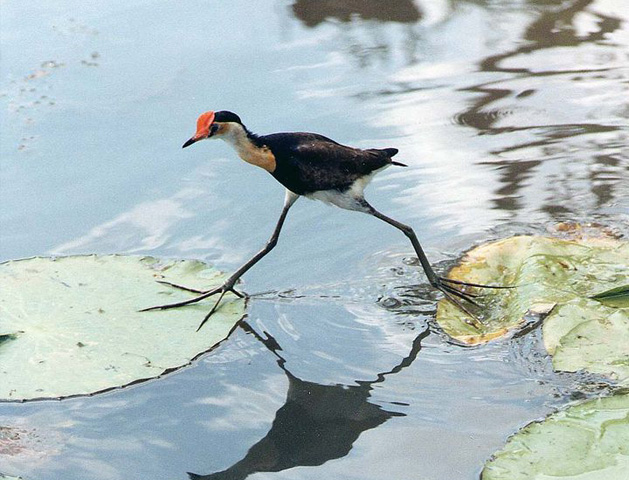
Comb-crested Jacana (Irediparra gallinacea)
| Scientific
classification |
| Kingdom: |
Animalia |
| Phylum: |
Chordata |
| Class: |
Aves |
| Order: |
Charadriiformes |
| Family: |
Jacanidae
Stejneger, 1885
|
| Genera |
•
Microparra
• Actophilornis
• Irediparra
• Hydrophasianus
• Metopidius
• Jacana |
The jacanas or jaçanas (sometimes referred to as Jesus birds)
are a group of tropical waders in the family Jacanidae. They are found
worldwide within the tropical zone. See Etymology below for proper
pronunciation.
They are identifiable by their huge feet and claws which enable them
to walk on floating vegetation in the shallow lakes that are their
preferred habitat. They have sharp bills and rounded wings, and many
species also have wattles on their foreheads
The females are larger than the males; the latter, as in some other
wader families like the phalaropes take responsibility for incubation,
and some species (notably the Northern Jacana) are polyandrous. However,
adults of both sexes look identical, as with most shorebirds. They
construct relatively flimsy nests on floating vegetation, and lay
eggs with dark irregular lines on their shells, providing camouflage
amongst water weeds
Its diet consists of insects and other invertebrates picked from the
floating vegetation or the water’s surface.
Most species are sedentary, but the Pheasant-tailed Jacana migrates
from the north of its range into peninsular India and southeast Asia.
Etymology
Jacana is Linnæus' scientific Latin misspelling of the Brazilian
Portuguese jaçanã (from a Tupi name of the bird), whose
pronunciation is approximately [ža.sa.náN]. The best English-language
representation of this might be "zhah-sah-NAH" or the more
flowing "zhah-SAH-nah".
Species
FAMILY: JACANIDAE
• Genus: Microparra
o Lesser Jacana - Microparra capensis
• Genus: Actophilornis
o African Jacana - Actophilornis africana
o Madagascar Jacana - Actophilornis albinucha
• Genus: Irediparra
o Comb-crested Jacana - Irediparra gallinacea
• Genus: Hydrophasianus
o Pheasant-tailed Jacana - Hydrophasianus chirurgus
• Genus: Metopidius
o Bronze-winged Jacana - Metopidius indicus
• Genus: Jacana
o Northern Jacana - Jacana spinosa
o Wattled Jacana - Jacana jacana
Little Cormorant
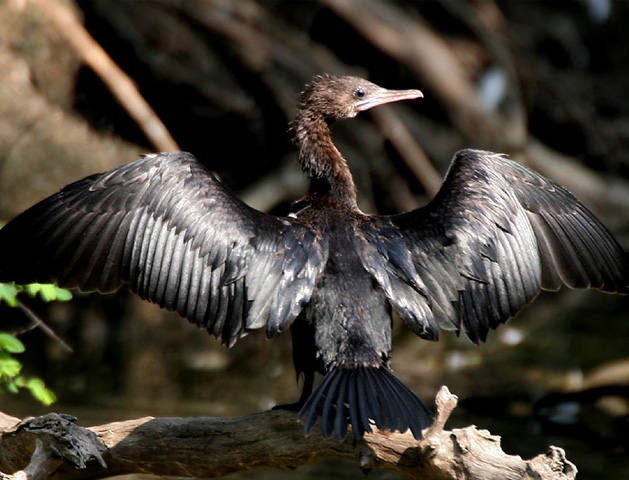
| Conservation
status |
.Least
Concern (IUCN 3.1) |
Scientific
classification |
| Kingdom: |
Animalia |
| Phylum: |
Chordata
|
| Class: |
Aves |
| Order: |
Pelecaniformes |
| Family: |
Phalacrocoracidae |
| Genus: |
Phalacrocorax |
| Species: |
P.
niger |
| Binomial
name |
Phalacrocorax
niger
Vieillot, 1817 |
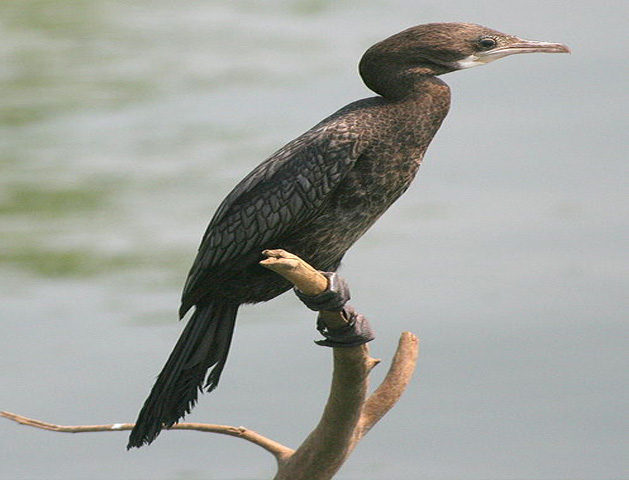
Breeding
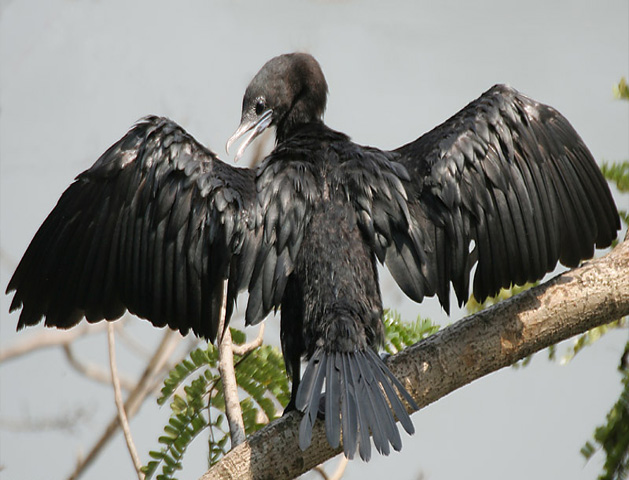
Drying its wings.
The Little Cormorant (Phalacrocorax niger) is a member of the cormorant
family of seabirds. It breeds in tropical south Asia from southern
Pakistan through India and Sri Lanka east to Indonesia. It is resident
but undertakes some limited seasonal movements.
Originally described by French ornithologist Louis Jean Pierre Vieillot
in 1817, this is a common and widespread bird species. It breeds in
freshwater wetlands and on coasts. 3-5 eggs are laid in a nest in
a tree or long grass.
This is a small cormorant, 55 cm in length. Its rectangular head profile
and short bill are distinctions from the somewhat larger Indian Cormorant.
Little Cormorant is mainly glossy black in the breeding season, with
white head plumes and a whitish throat. The wing coverts are silvery,
and it has a longish tail.
The sexes are similar, but non-breeding adults and juveniles are browner
and lack the head plumes.
The Little Cormorant can dive to considerable depths, but usually
feeds in shallow water. It frequently brings prey to the surface.
A wide variety of fish are taken
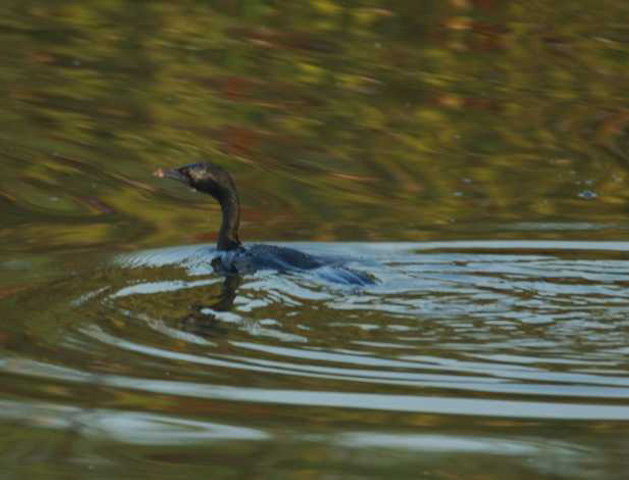
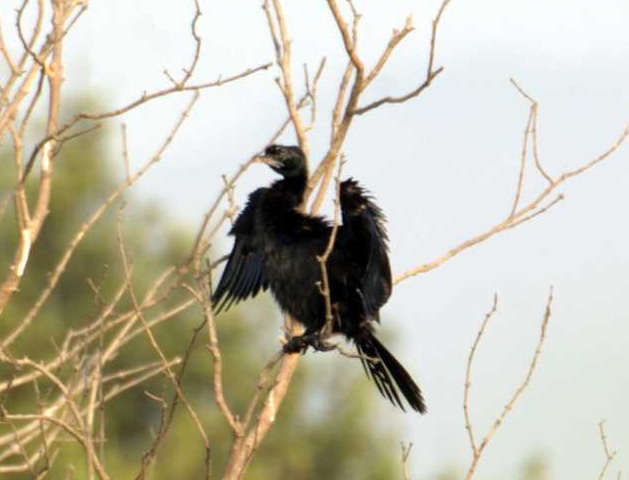
:::::::::::::::::::::::::::::::::::::::::::::::::::::::::::::::::::::::::::::::::::::::::::::::::::::::::::::::::::::::::::::::::::::::::::::::::::::::::::::::::::::::::::::::::::::::::::::::::::::::::::::::::::::::::::::::::::
Little Egret
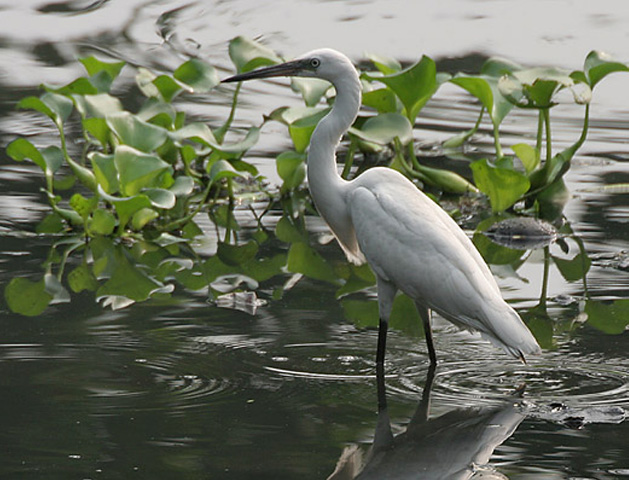
| Conservation
status |
| Least
Concern (IUCN 3.1) |
| Scientific
classification |
| Kingdom: |
Animalia |
| Phylum: |
Chordata |
| Class: |
Aves |
| Order: |
Ciconiiformes
(disputed) |
| Family: |
Ardeidae |
| Genus: |
Egretta |
| Species: |
E.
garzetta |
| Binomial
name |
Egretta
garzetta
Linnaeus, 1766 |
The Little Egret, Egretta garzetta is a small white heron. It is the
Old World counterpart to the very similar New World Snowy Egret.
Subspecies
There are at least two subspecies of Little Egret. The nominate subspecies
E. g. garzetta occurs in Europe, Africa and Asia. E. g. nigripes breeds
in Indonesia and Australasia. Those in Australia are sometimes thought
to represent a third subspecies E. g. immaculata.
Several other egret taxa have at times been classified as subspecies
of the Little Egret in the past but are now regarded as separate species.
The Western Reef-Egret, Egretta gularis occurs on the coastline of
West Africa (race gularis) and from the Red Sea to India (race schistacea).
The Dimorphic Egret, Egretta (garzetta/gularis) dimorpha is found
in East Africa, Madagascar, the Comoros and the Aldabra Islands.
Description
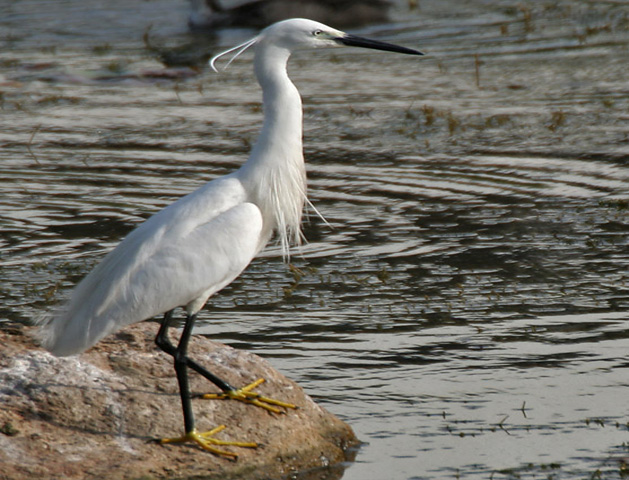
E. g. garzetta - in breeding plumage
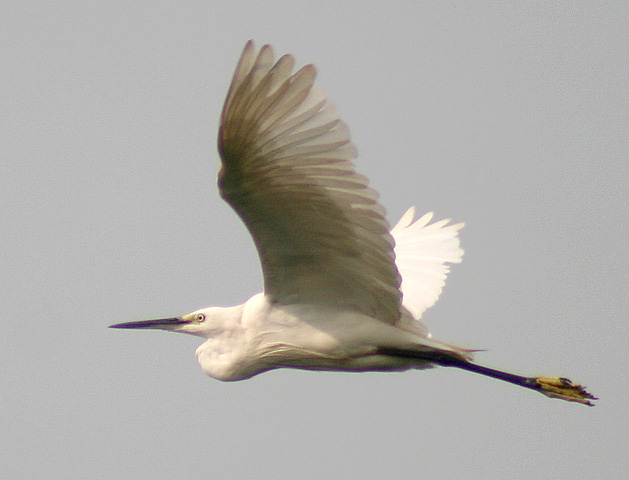
E. g. garzetta - in flight
Little Egret stands on a leaf in an aviary
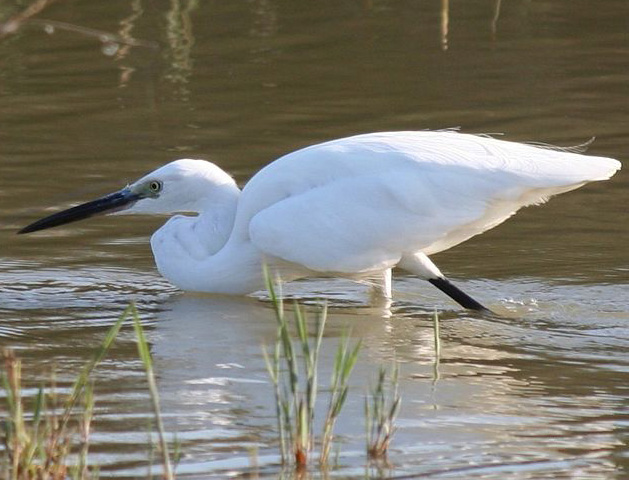
Little Egret (Non-breeding plumage)stalking
The adult Little Egret is 55–65 cm long with an 88–106
cm wingspan. It weighs 350–550 grams. Its plumage is all white.
It has long black legs with yellow feet and a slim black bill. In
the breeding season, the adult has two long nape plumes and gauzy
plumes on the back and breast. The bare skin between the bill and
eyes becomes red or blue. Juveniles are similar to non-breeding adults
but have duller legs and feet. The subspecies garzetta has yellow
feet and a bare patch of grey-green skin between the bill and eyes,
whereas nigripes has yellow skin between the bill and eye and blackish
feet.
Little Egrets are mostly silent but make various croaking and bubbling
calls at their breeding colonies and produce a harsh alarm call when
disturbed.
Distribution and habitat
Its original breeding distribution was large inland wetlands and coastal
wetlands in warm temperate parts of Europe, Asia, Africa and Australia.
In warmer locations, most birds are permanent residents; northern
populations, including many European birds, migrate to Africa and
southern Asia. They may also wander north after the breeding season,
which presumably has led to this egret's range expansion.
Colonization of the New World
The Little Egret has now started to colonize the New World. The first
record there was on Barbados in April 1954. It began breeding on the
island in 1994. Birds are seen with increasing regularity and have
occurred from Surinam and Brazil in the south to Newfoundland and
Quebec in the north. Birds on the east coast of North America are
thought to have moved north with Snowy Egrets from the Caribbean.
Northward spread in Europe
Until the 1950s, the Little Egret was restricted to southern Europe.
Over the next few decades it became increasingly common in western
France and later on the north coast. It bred in the Netherlands in
1979 with further breeding in the 1990s.
In Great Britain it was rare until the late twentieth century and
almost certainly did not breed. In contrast, it has for just over
a decade now become a regular breeding species and is commonly sighted,
often in large numbers at favoured coastal sites. The first breeding
record is generally accepted as having been on Brownsea Island in
Dorset in 1996, although it has been claimed that the species bred
in Sussex in the 1970s. There are now several colonies across southern
England and the species bred in Wales for the first time in 2002.
In Ireland the species bred for the first time in 1997 at a site in
County Cork.
Reproduction
The Little Egret nests in colonies, often with other wading birds,
usually on platforms of sticks in trees or shrubs or in a reedbed
or bamboo grove. In some locations such as the Cape Verde Islands,
the species nests on cliffs. Pairs defend a small breeding territory,
usually extending around 3–4 m from the nest. The three to five
eggs are incubated by both adults for 21–25 days to hatching.
They are oval in shape and have a pale, non-glossy, blue-green colour.
The young birds are covered in white down feathers, are cared for
by both parents and fledge after 40 to 45 days.
Feeding
E. g. garzetta in Breeding plumage-actively catching prey
This egret stalks its prey in shallow water, often running with raised
wings or shuffling its feet. It may also stand still and wait to ambush
prey. It eats a variety of small animals including fish, amphibians,
crustaceans, and insects.
Conservation
At one time, the plumes of the Little Egret and other egrets were
in demand for decorating hats. They had been used for this purpose
since at least the 17th century but in the 19th century it became
a major craze and the number of egret skins passing through dealers
reached into the millions. Egret farms were set up where the birds
could be plucked without being killed but most of the supply was obtained
by hunting which reduced the population of the species to dangerously
low levels (stimulating the establishment of Britain's Royal Society
for the Protection of Birds in 1889). Now conservation laws protect
this species, and the population has rebounded strongly.
The Little Egret is not listed as a threatened species on the Australian
Environment Protection and Biodiversity Conservation Act 1999. However,
it status varies from state to state within Australia. For example:
• The Little Egret subspecies E. g. nigripes is listed as threatened
on the Victorian Flora and Fauna Guarantee Act (1988).[4] Under this
Act, an Action Statement for the recovery and future management of
this species has been prepared
• On the 2007 advisory list of threatened vertebrate fauna in
Victoria, the Little Egret (E. g. nigripes) is listed as endangered
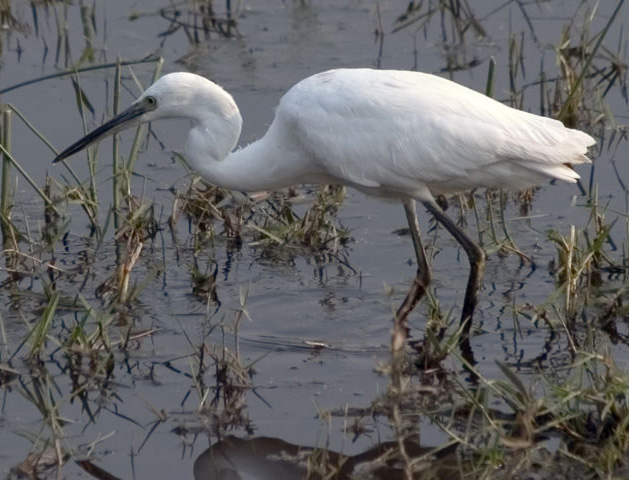

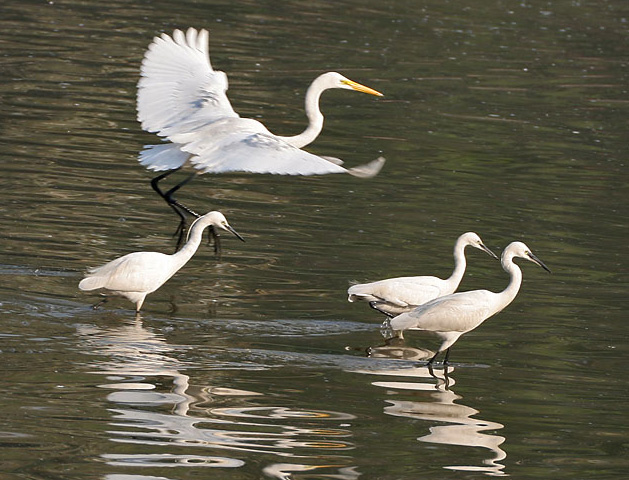
:::::::::::::::::::::::::::::::::::::::::::::::::::::::::::::::::::::::::::::::::::::::::::::::::::::::::::::::::::::::::::::::::::::::::::::::::::::::::::::::::::::::::::::::::::::::::::::::::::::::::::::::::::::::::::::::::::
Monarch flycatcher
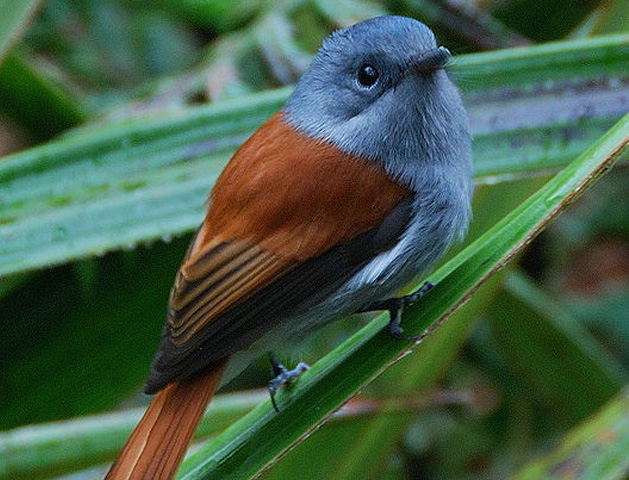 .Mascarene Paradise-flycatcher
.Mascarene Paradise-flycatcher
Terpsiphone bourbonnensis
| Scientific
classification |
| Kingdom: |
Animalia |
| Phylum |
Chordata |
| Class: |
Aves |
| Order: |
Passeriformes |
| Suborder: |
Passeri |
| Family: |
Monarchidae |
| Genera |
| See
text |
The
monarch flycatchers, Monarchidae, are a family of passerine birds.
Well-known forms included here are boatbills, monarch flycatchers,
shrikebills, paradise-flycatchers, and the magpie-larks.
Monarchids are small songbirds with long tails. They are insectivorous
birds, living in forest or woodland across sub-Saharan Africa, South-East
Asia, Australasia, and a number of Pacific islands. Only a few species
migrate. Many species decorate their cup-shaped nests with lichen.
Morphology and description
The monarch flycatchers are a diverse family of passerine birds that
are generally arboreal (with the exception of the magpie-larks). They
are mostly slim birds and possess broad bills. The bills of some species
are quite large; the boatbills of the genus Machaerirhynchus are very
broad and flat, and the heavy-set bills of the shrikebills are used
to probe dead wood and leaves. The plumage of the family ranges from
sombre, like the almost monochrome Black Monarch, to spectacular,
like the Golden Monarch. The tails are generally long and spectacularly
so in the paradise-flycatchers in the genus Terpsiphone. Sexual dimorphism
in plumage can be subtle, as in the Paperbark Flycatcher, where the
female is identical to the male except for a slight buff on he throat;
striking, as in the Chuuk Monarch where the male almost entirely white
and the female entirely black; or non-existent, as in the Tahiti Monarch.
In some species, for example the Madagascar Paradise-flycatcher, the
males have two or more colour morphs.
Distribution, habitat and movements
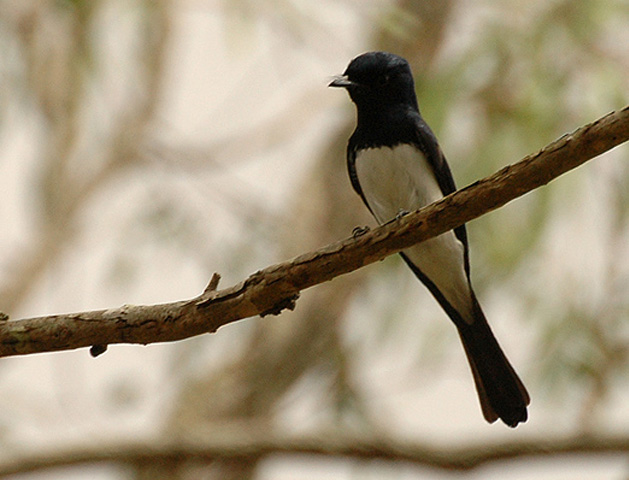
The Satin Flycatcher is fully migratory, breeding in southern Australia
and migrating to northern Australia and New Guinea.
The monarch flycatchers have an mostly Old World distribution. In
the western end of their range they are distributed through sub-Saharan
Africa, Madagascar and the islands of the tropical Indian Ocean. They
also occur in South and Southeastern Asia, north to Japan, down to
New Guinea and most of Australia. The family has managed to reach
many Pacific islands, and several endemic genera occur across Micronesia,
Melanesia and Polynesia as far as Hawaii and the Marquesas.
The paradise-flycatchers of the genus Terpsiphone has the widest distribution
of any of the monarch flycatchers, ranging almost all of sub-Saharan
Africa, Madagascar, the Mascarenes and Seychelles, South, East and
Southeastern Asia as far as Korea, Afghanistan, the Philippines and
the Lesser Sundas. The other paradise-flycatcher genus, Trochocercus
is restricted to Africa. The other exclusively Asian genus is the
Hypothymis monarchs. The remaining genera are predominately found
in the Austro-Papuan and Oceania regions. A few monotypic genera are
restricted to Pacific island; these include the Silktail (Lamprolia)
in Fiji, the Chuuk Monarch (Metabolus) in the Micronesian island of
Chuuk, the Hawaiian Elepaio (Chasiempis) and the Buff-bellied Monarch
(Neolalage) which is restricted to the islands of Vanuatu. Other Pacific
genera are the shrikebills (Clytorhynchus), the Mayrornis monarchs,
both of which are found in Melanesia and west Polynesia, and the Pomarea
monarchs which are exclusively Polynesian in origin.
The majority of the family is found in forest and woodland habitats.
Species that live in more open woodlands tend to live in the higher
levels of the trees but, in denser forest, live in the middle and
lower levels. Other habitats used by monarch flycatchers include savannah
and mangroves, and the terrestrial Magpie-lark occurs in most Australian
habitats except the driest deserts.
While the majority of monarch-flycatchers are resident, a few species
are partially migratory and one, the Satin Flycatcher, is fully migratory,
although the Japanese Paradise-flycatcher is almost entirely migratory.
The Asian Paradise-flycatcher is migratory over the northern parts
of its range and sedentary in the tropics, and the African Paradise-flycatcher
makes a series of poorly understood intra-African migratory movements.
Breeding

Female Pale-blue Monarch on a nest constructed on a fork in a tree.
The monarch-flycatchers are generally monogamous, with the pair bonds
ranging from just a single season (as in the African Paradise-flycatcher)
to life (the Elepaio). Only three species are known to engage in cooperative
breeding; but many species are as yet unstudied. They are generally
territorial, defending territories that are around 2 ha in size, but
a few species may cluster their nesting sites closely together. Nesting
sites may also be chosen close to aggressive species, for example
Leaden Flycatchers nests may be located near the nests of the aggressive
Noisy Friarbird. The nests are in turn often aggressively defended
by monarch flycatchers. In all species the nest is a open cup on a
branch, fork or twig. In some species the nests can be highly conspicuous.
Systematics
Many of the approximately 140 species making up the family were previously
assigned to other groups, largely on the basis of general morphology
or behaviour. The Magpie-lark, for example, was assigned to the same
family as the White-winged Chough, since both build unusual nests
from mud rather than vegetable matter. The Australasian fantails were
thought to be allied with the fantails of the northern hemisphere
(they have a similar diet and behaviour), and so on.
With the new insights generated by the DNA-DNA hybridisation studies
of Sibley and his co-workers toward the end of the 20th century, however,
it became clear that these apparently unrelated birds were all descended
from a common ancestor: the same crow-like ancestor that gave rise
to the drongos. On that basis they have been included as a subfamily
of the Dicruridae, along with the fantails, although Christidis and
Boles have more recently treated it at familial rank as Monarchidae.
More recently, the grouping has been refined somewhat as the original
concept of Corvida has proven paraphyletic. The narrower 'Core corvine'
group now comprises the crows and ravens, shrikes, birds of paradise,
fantails, monarch flycatchers, drongos and mudnest builders.
The Monarchs are small to medium-sized insectivorous passerines, many
of which hunt by flycatching.
Taxonomic list of Monarchidae
Based on del Hoyo et al (2006)
• Genus Hypothymis (4 species)
• Genus Eutrichomyias – Cerulean Paradise-flycatcher
• Genus Trochocercus
o Blue-headed Crested Flycatcher, Trochocercus nitens
o African Crested Flycatcher, Trochocercus cyanomelas
• Genus Terpsiphone – typical paradise-flycatchers (14
species)
• Genus Chasiempis – ?Elepaio
• Genus Pomarea
o Eiao Monarch, Pomarea fluxa – extinct (late 1970s). Formerly
included in P. mendozae
o Nuku Hiva Monarch, Pomarea nukuhivae – extinct (20th century).
Formerly included in P. iphis
o Rarotonga Monarch, Pomarea dimidiata
o Tahiti Monarch,Pomarea nigra
o Marquesas Monarch, Pomarea mendozae
? Hiva Oa Monarch, Pomarea mendozae mendozae – extinct (late
1970s)
o Ua Pou Monarch, Pomarea mira – extinct (c. 1986). Formerly
included in P. mendozae
o Maupiti Monarch, Pomarea pomarea – extinct (mid-19th century)
o Iphis Monarch, Pomarea iphis
o Fatuhiva Monarch, Pomarea whitneyi
• Genus Mayrornis (3 species)
• Genus Neolalage (1 species)
• Genus Clytorhynchus, Shrikebills (5 species)
• Genus Metabolus (1 species)
• Genus Monarcha
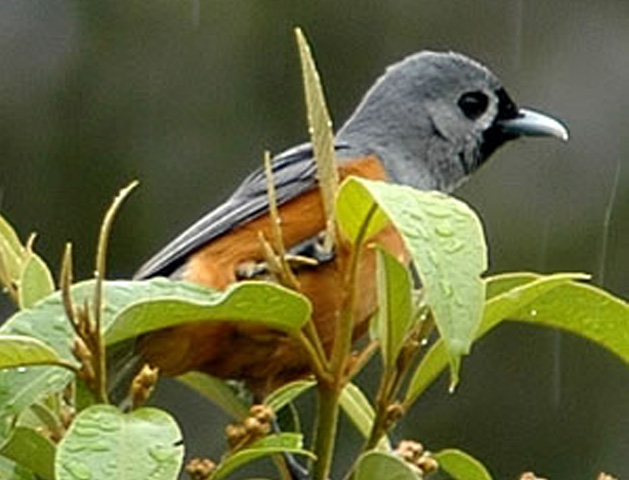
Black-faced Monarch, Monarcha melanopsis
o Black Monarch, Monarcha axillaris
o Rufous Monarch, Monarcha rubiensis
o Island Monarch, Monarcha cinerascens
o Black-faced Monarch, Monarcha melanopsis
o Black-winged Monarch, Monarcha frater
o Bougainville Monarch, Monarcha erythrostictus
o Chestnut-bellied Monarch, Monarcha castaneiventris
o White-capped Monarch, Monarcha richardsii
o White-eared Monarch, Monarcha leucotis
o White-naped Monarch, Monarcha pileatus
o Loetoe Monarch, Monarcha castus
o Spot-winged Monarch, Monarcha guttulus
o Black-bibbed Monarch, Monarcha mundus
o Flores Monarch, Monarcha sacerdotum
o Black-chinned Monarch, Monarcha boanensis
o Spectacled Monarch, Monarcha trivirgatus
o White-tailed Monarch, Monarcha leucurus
o White-tipped Monarch, Monarcha everetti
o Black-tipped Monarch, Monarcha loricatus
o Black-backed Monarch, Monarcha julianae
o Biak Monarch, Monarcha brehmii
o Hooded Monarch, Monarcha manadensis
o Manus Monarch, Monarcha infelix
o White-breasted Monarch, Monarcha menckei
o Black-tailed Monarch, Monarcha verticalis
o Black-and-white Monarch, Monarcha barbatus
o Kulambangra Monarch, Monarcha browni
o White-collared Monarch, Monarcha viduus
o Yap Monarch, Monarcha godeffroyi
o Tinian Monarch, Monarcha takatsukasae
o Golden Monarch, Monarcha chrysomela
• Genus Arses (4 species)
• Genus Myiagra
o Guam Flycatcher, Myiagra freycineti – extinct (1983)
o Oceanic Flycatcher, Myiagra oceanica
o Palau Flycatcher, Myiagra erythrops
o Pohnpei Flycatcher, Myiagra pluto
o Moluccan Flycatcher, Myiagra galeata
o Biak Flycatcher, Myiagra atra
o Leaden Flycatcher, Myiagra rubecula
o Steel-blue Flycatcher, Myiagra ferrocyanea
Broad-billed Flycatcher, Myiagra ruficollis
•
o Ochre-headed Flycatcher, Myiagra cervinicauda
o Melanesian Flycatcher, Myiagra caledonica
o Vanikoro Flycatcher, Myiagra vanikorensis
o Samoan Flycatcher, Myiagra albiventris
o Blue-crested Flycatcher, Myiagra azureocapilla
o Broad-billed Flycatcher, Myiagra ruficollis
o Satin Flycatcher, Myiagra cyanoleuca
o Shining Flycatcher, Myiagra alecto
o Dull Flycatcher, Myiagra hebetior
o Paperbark Flycatcher, Myiagra nana
o Restless Flycatcher, Myiagra inquieta
• Genus Lamprolia – Silktail (Taxonomic position uncertain)
• Genus Machaerirhynchus – boatbills (2 species –
Taxonomic position uncertain)
• Genus Elminia
o African Blue Flycatcher, Elminia longicauda
o White-tailed Blue Flycatcher, Elminia albicauda
o Dusky Crested Flycatcher, Elminia nigromitrata
o White-bellied Crested Flycatcher, Elminia albiventris
o White-tailed Crested Flycatcher, Elminia albonotata
• Genus Erythrocercus – probably belongs to the Cettiidae
o Yellow Flycatcher, Erythrocercus holochlorus
o Chestnut-capped Flycatcher, Erythrocercus mccallii
o Livingstone's Flycatcher, Erythrocercus livingstonei
• Genus Grallina Magpie-larks (2 species)
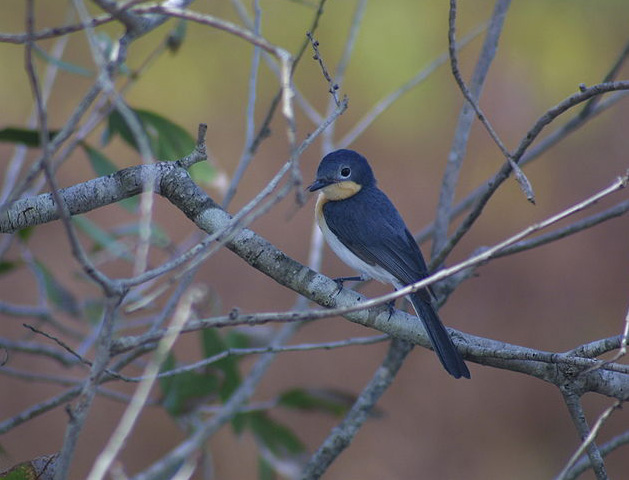
:::::::::::::::::::::::::::::::::::::::::::::::::::::::::::::::::::::::::::::::::::::::::::::::::::::::::::::::::::::::::::::::::::::::::::::::::::::::::::::::::::::::::::::::::::::::::::::::::::::::::::::::::::::::::::::::::::
Night Heron



:::::::::::::::::::::::::::::::::::::::::::::::::::::::::::::::::::::::::::::::::::::::::::::::::::::::::::::::::::::::::::::::::::::::::::::::::::::::::::::::::::::::::::::::::::::::::::::::::::::::::::::::::::::::::::::::::::
Purple Heron
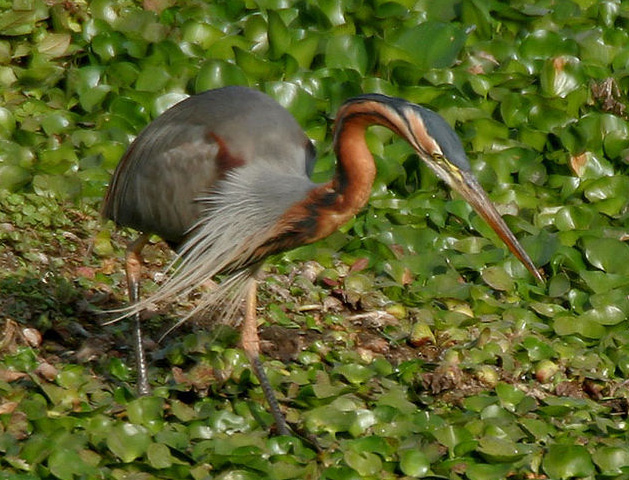
| Conservation
status |
| Least
Concern (IUCN 3.1) |
| Scientific
classification |
| Kingdom: |
Animalia |
| Phylum: |
Chordata |
| Class: |
Aves |
| Order: |
Ciconiiformes |
| Family: |
Ardeidae |
| Genus: |
Ardea |
| Species: |
A.
purpurea |
| Binomial
name |
Ardea
purpurea
(Linnaeus, 1766) |
The Purple Heron (Ardea purpurea) is a wading bird in the heron family
Ardeidae, breeding in Africa, central and southern Europe, and southern
and eastern Asia. The European populations are migratory, wintering
in tropical Africa; the more northerly Asian populations also migrate
further south within Asia. It is a rare but regular wanderer north
of its breeding range.
Description
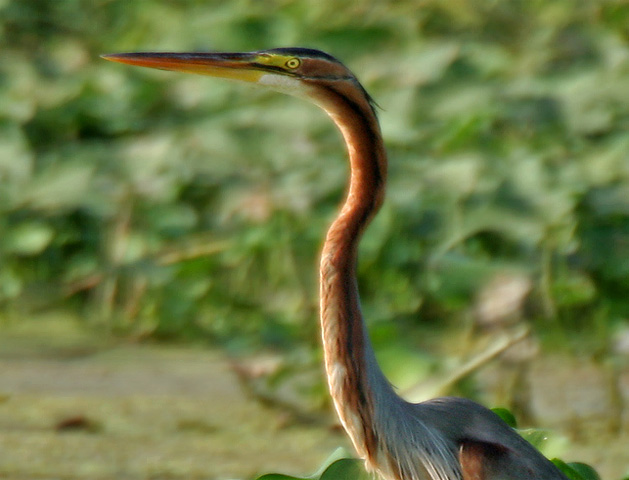
Ardea purpurea manilensis
The Purple Heron is a large bird, 80-90 cm tall, with a 120-150 cm
wingspan, but slender for its size, weighing only 0.5-1.3 kg. It is
somewhat smaller than the Grey Heron, from which it can be distinguishes
by its darker reddish-brown plumage, and, in adults, darker grey back.
It has a narrower yellow bill, which is brighter in breeding adults.
Taxonomy
There are three or four subspecies:
• Ardea purpurea purpurea Linnaeus, 1766. Africa, Europe north
to the Netherlands, and southwestern Asia east to Kazakhstan.
• Ardea purpurea bournei (de Naurois, 1966). Cape Verde Islands
(included in purpurea by some authors, but treated as a distinct species
Ardea bournei by some others).
• Ardea purpurea madagascariensis Oort, 1910. Madagascar.
• Ardea purpurea manilensis Meyen, 1834. Asia from Pakistan
east to the Philippines and north to Primorsky Krai, Russia.
Behaviour
The Purple Heron breeds in colonies in reed beds or trees close to
large lakes or other extensive wetlands. It builds a bulky stick nest.
It feeds in shallow water, spearing fish, frogs or insects with its
long, sharp bill. It will often wait motionless for prey, or slowly
stalk its victim. It tends to keep within reedbeds more than the Grey
Heron, and is often inconspicuous, despite its size.

In flight it has a slow flight, with its neck retracted. This is characteristic
of herons and bitterns, and distinguishes them from storks, cranes
and spoonbills, which extend their necks. The long neck of Purple
Heron looks particularly snake-like, with more of an S-shape in flight.
The call is a loud croaking "krek".
The Purple Heron is one of the species to which the Agreement on the
Conservation of African-Eurasian Migratory Waterbirds (AEWA) applies.
:::::::::::::::::::::::::::::::::::::::::::::::::::::::::::::::::::::::::::::::::::::::::::::::::::::::::::::::::::::::::::::::::::::::::::::::::::::::::::::::::::::::::::::::::::::::::::::::::::::::::::::::::::::::::::::::::::
Stork-billed Kingfisher

| Conservation
status |
| Least
Concern (IUCN 3.1) |
| Scientific
classification |
| Kingdom |
Animalia |
| Phylum: |
Chordata |
| Class: |
Aves |
| Order: |
Coraciiformes |
| Family: |
Halcyonidae |
| Genus: |
Pelargopsis |
| Species: |
P.
capensis |
| Binomial
name |
Pelargopsis
capensis
(Linnaeus, 1766) |
| Synonyms |
| Halcyon
capensis |
The
Stork-billed Kingfisher, Pelargopsis capensis (formerly Halcyon capensis),
is a tree kingfisher which is widely but sparsely distributed in tropical
south Asia from India and Sri Lanka to Indonesia. This kingfisher
is essentially resident throughout its range.
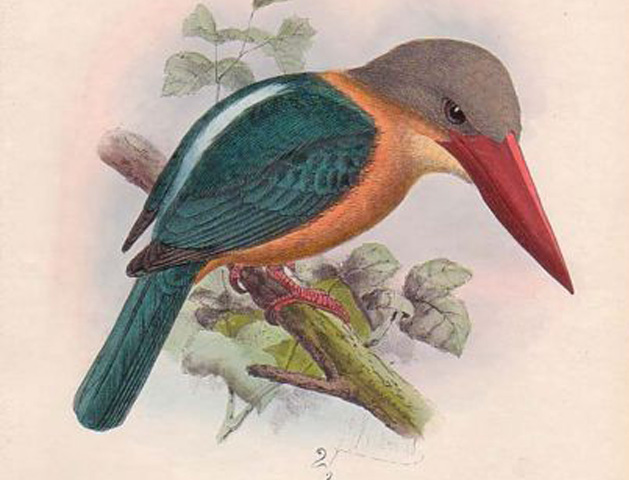
This is a very large kingfisher, 35 cm in length. The adult has a
green back, blue wings and tail, and grey head. Its underparts and
neck are buff. The very large bill and legs are bright red. The flight
of the Stork-billed Kingfisher is laboured and flapping, but direct.
Sexes are similar. There are 15 races, mostly differing in plumage
detail, but P. c. gigantea of the Sulu Islands has a white head, neck
and underparts. The call of this noisy kingfisher is a low and far
reaching peer-por-por repeated every 5 seconds or so as well cackling
ke-ke-ke-ke-ke-ke.
Stork-billed Kingfisher is a species of a variety of well-wooded habitats
near lakes, rivers or coasts. It perches quietly whilst seeking food,
and is often inconspicuous despite its size. It is territorial and
will chase away eagles and other large predators. This species hunts
fish, frogs, crabs, rodents and young birds.
Stork-billed Kingfisher digs its nest in a river bank, decaying tree,
or a tree termite nest. A clutch of two to five round white eggs is
typical.
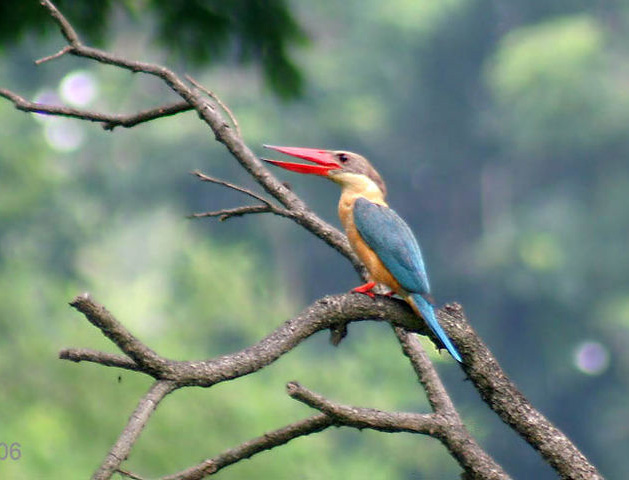
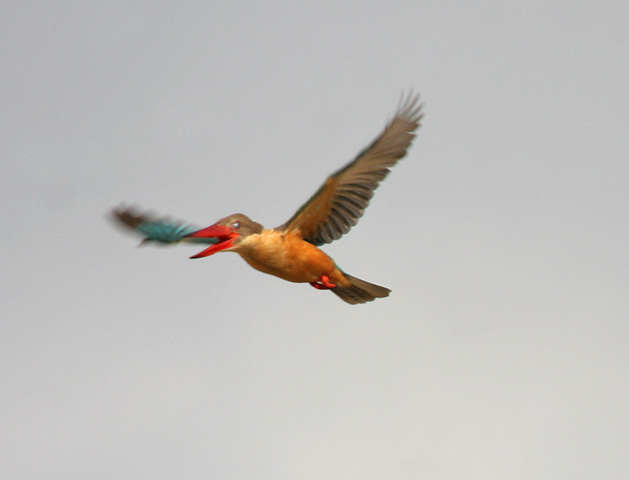

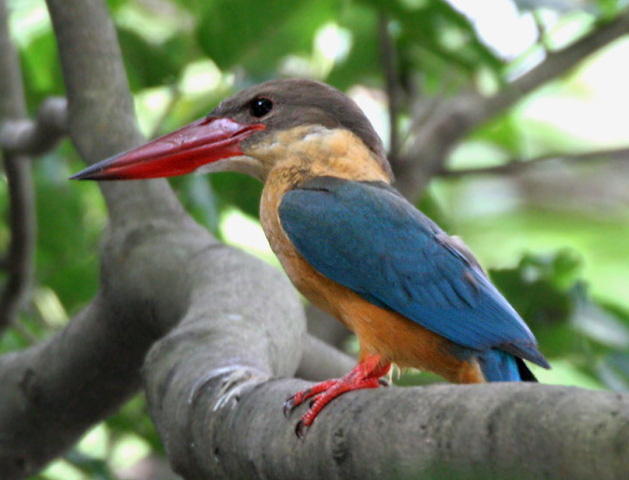
:::::::::::::::::::::::::::::::::::::::::::::::::::::::::::::::::::::::::::::::::::::::::::::::::::::::::::::::::::::::::::::::::::::::::::::::::::::::::::::::::::::::::::::::::::::::::::::::::::::::::::::::::::::::::::::::::::
Whiskered Tern
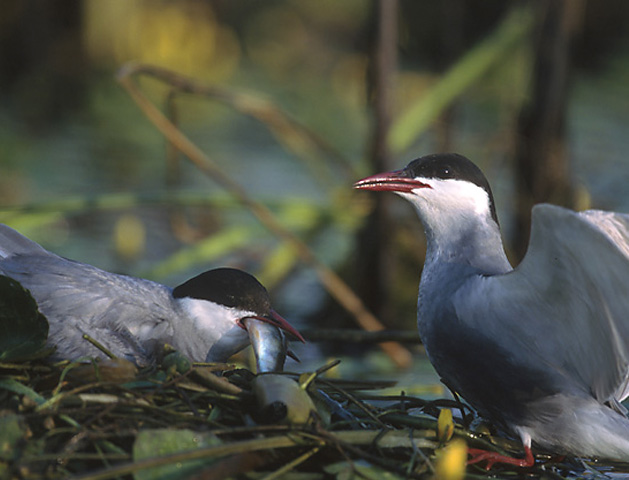
| Conservation
status |
| Least
Concern (IUCN 3.1) |
| Scientific
classification |
| Kingdom: |
Animalia |
| Phylum: |
Chordata |
| Class: |
Aves |
| Order: |
Charadriiformes |
| Family: |
Sternidae |
| Genus: |
Chlidonias |
| Species: |
C.
hybridus |
| Binomial
name |
Chlidonias
hybridus
(Pallas, 1811) |
| Subspecies |
•
C. h. hybridus
(Eurasian Whiskered Tern)
• C. h. delalandii
(African Whiskered Tern)
• C. h. javanicus
(Australasian Whiskered Tern) |
The Whiskered Tern (Chlidonias hybridus) is a seabird of the tern
family Sternidae. This bird has a number of geographical races, differing
mainly in size and minor plumage details.
C. h. hybridus breeds in warmer parts of Europe and Asia. The smaller-billed
and darker C. h. delalandii is found in east and south Africa, and
the paler C. h. javanicus from Java to Australia.
The tropical forms are resident, but European and Asian birds winter
south to Africa and southern Asia.
This species breeds in colonies on inland marshes, sometimes amongst
Black-headed Gulls, which provide some protection. The scientific
name arises from the fact that this, the largest marsh tern, show
similarities in appearance to both the white Sterna terns and to Black
Tern.
Description
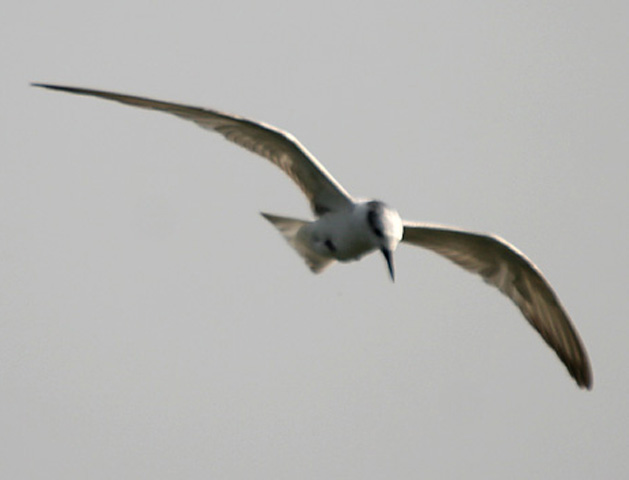
The size, black cap, strong bill (29-34 mm in males, 25-27 mm and
stubbier in females, with a pronounced gonys) and more positive flight
recall Common or Arctic Tern, but the short, forked-looking tail and
dark grey breeding plumage above and below are typically marsh tern
characteristics. The summer adult has white cheeks and red legs and
bill. The crown is flecked with white in the juvenile, and the hindcrown
is more uniformly blackish, though in the winter adult this too is
flecked with white. The black ear-coverts are joined to the black
of the hindcrown, and the space above is mottled with white, causing
the black to appear as a C-shaped band. The sides of the neck are
white; this sometimes continues across the nape. The collar is less
sharply defined. All through the year the rump is pale grey. In the
juvenile, the mantle (279 mm) has a variegated pattern. The feathers
of the back and scapulars are dark brown, with prominent broad buff
edgings and often subterminal buff bars or centers. There is usually
an admixture of new gray feathers, especially on the mantle, quite
early in the fall. The mantle is silvery-gray in the adult. The call
is a characteristic krekk.
In winter, the forehead becomes white and the body plumage a much
paler grey. Juvenile Whiskered Terns have a ginger scaly back, and
otherwise look much like winter adults. The first winter plumage is
intermediate between juvenile and adult winter, with patchy ginger
on the back.
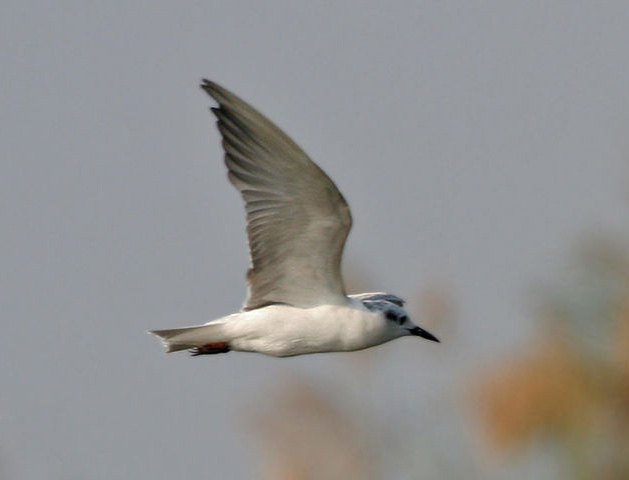
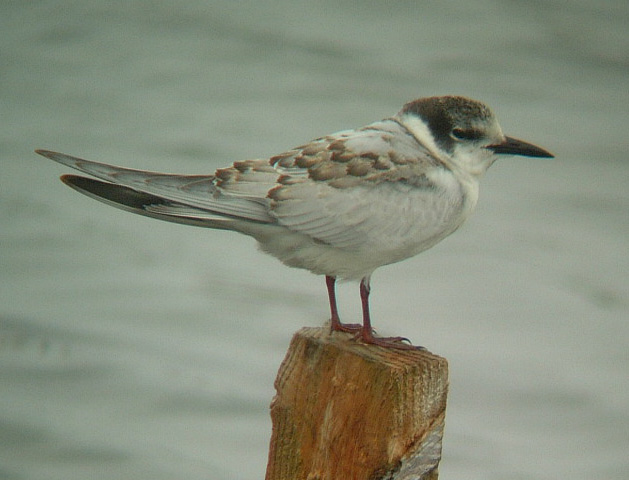
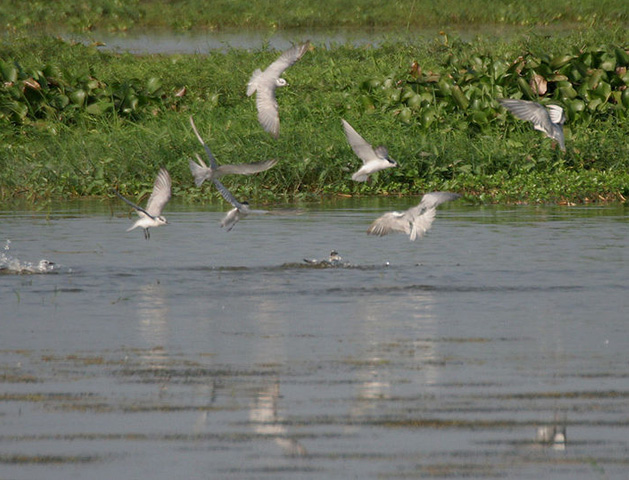
:::::::::::::::::::::::::::::::::::::::::::::::::::::::::::::::::::::::::::::::::::::::::::::::::::::::::::::::::::::::::::::::::::::::::::::::::::::::::::::::::::::::::::::::::::::::::::::::::::::::::::::::::::::::::::::::::::
Dendrocygninae or whistling duck
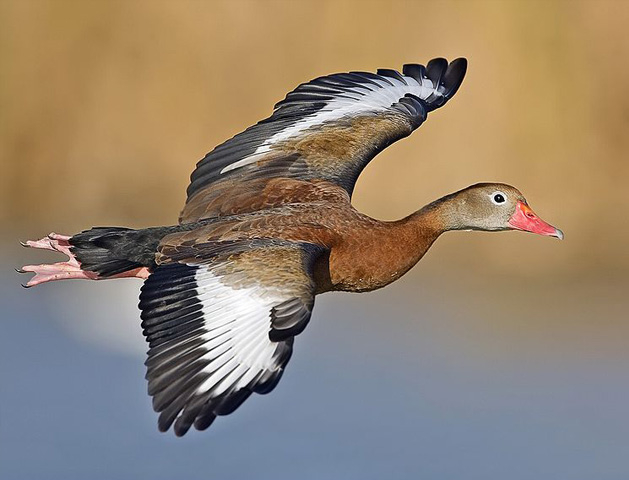
| Scientific
classification |
| Kingdom: |
Animalia |
| Phylum: |
Chordata |
| Class: |
Aves |
| Order: |
Anseriformes |
| Family: |
Anatidae |
| Subfamily: |
Dendrocygninae
Reichenbach, 1853 |
| Genus: |
Dendrocygna
Swainson, 1837 |
| Species |
•
Dendrocygna arborea
• Dendrocygna arcuata
• Dendrocygna autumnalis
• Dendrocygna bicolor
• Dendrocygna eytoni
• Dendrocygna guttata
• Dendrocygna javanica
• Dendrocygna viduata |
Dendrocygninae
is a subfamily of the duck, goose and swan family of birds, Anatidae.
In other taxonomical approaches, they are either considered a separate
family Dendrocygnidae, or a tribe Dendrocygnini
in the goose subfamily Anserinae (e.g. Terres & NAS, 1991).
It contains only one genus, Dendrocygna, containing eight living species,
and one known from hitherto undescribed subfossils from Aitutaki,
Cook Islands (Steadman, 2006). These species are the whistling ducks
and they have a worldwide distribution through the tropics and subtropics.
These ducks have, as their name implies, distinctive whistling calls.
The whistling ducks have long legs and necks, and
are very gregarious, flying to and from night-time roosts in large
flocks. Both sexes have the same plumage, and all have a hunched appearance
and black underwings in flight.
Species
• Black-billed Whistling Duck, Dendrocygna arborea
• Wandering Whistling Duck, Dendrocygna arcuata
• Black-bellied Whistling Duck, Dendrocygna autumnalis
• Fulvous Whistling Duck, Dendrocygna bicolor
• Plumed Whistling Duck, Dendrocygna eytoni
• Spotted Whistling Duck, Dendrocygna guttata
• Lesser Whistling Duck, or Indian Whistling Duck, Dendrocygna
javanica
• White-faced Whistling Duck, Dendrocygna viduata
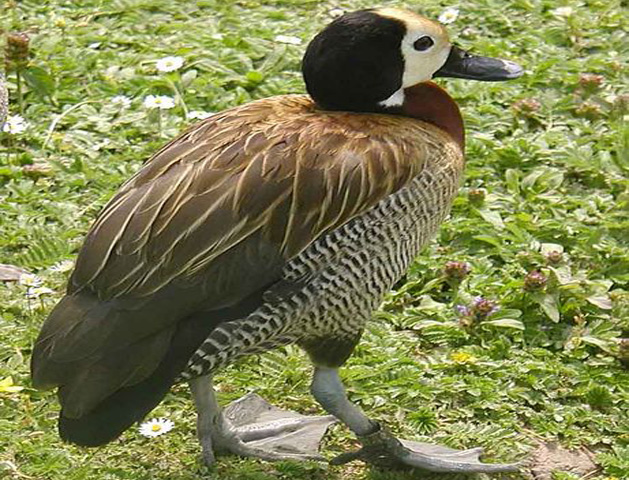 
|







































































































|